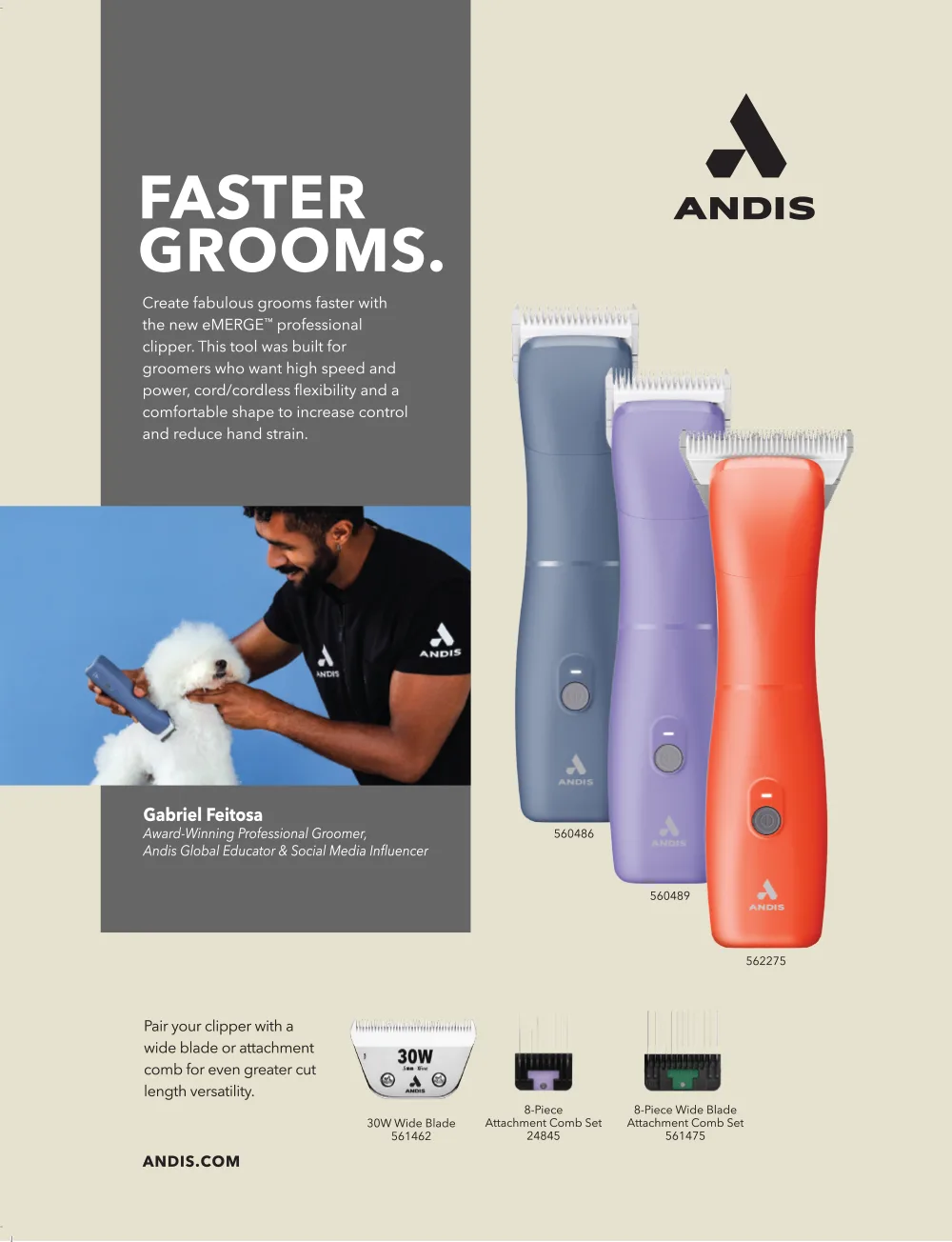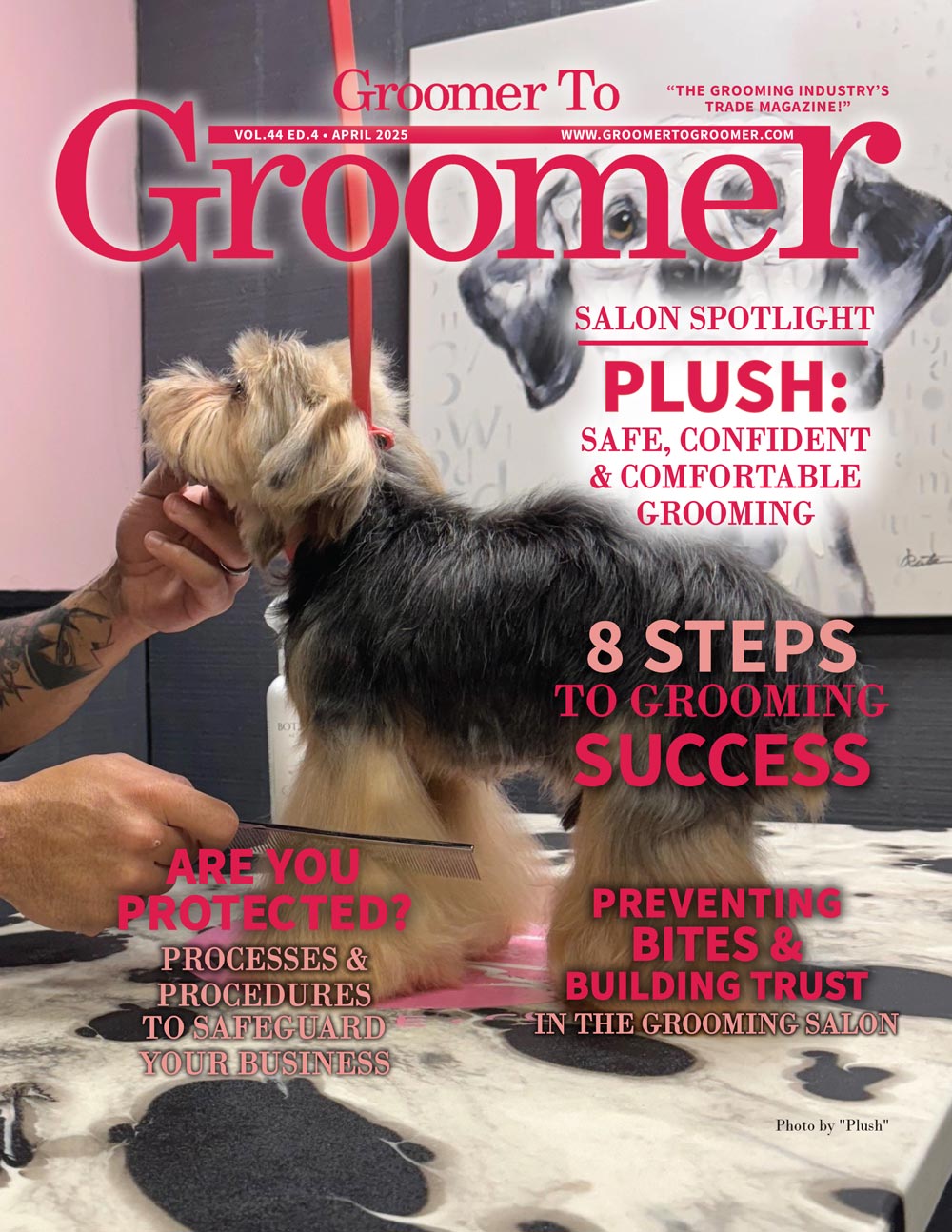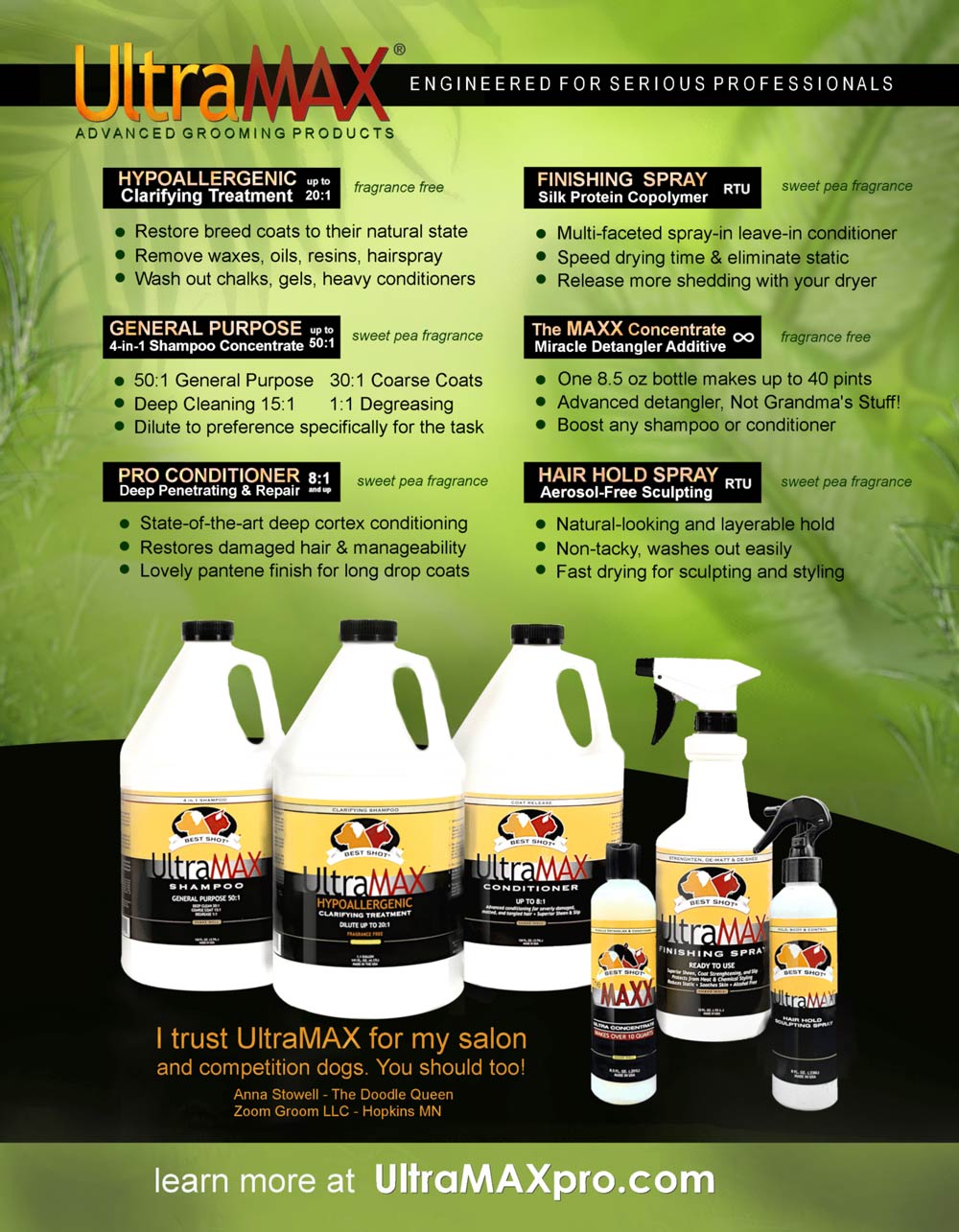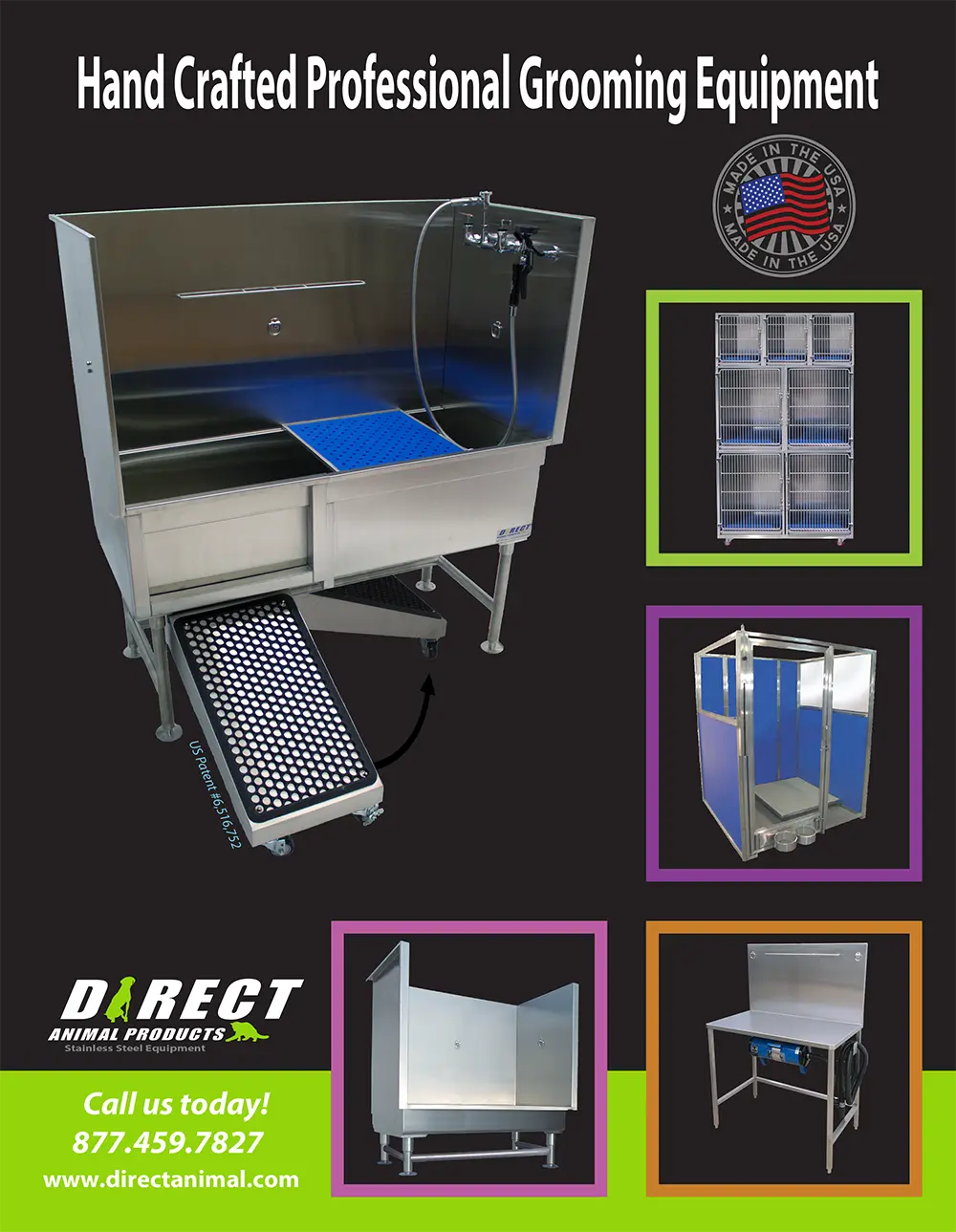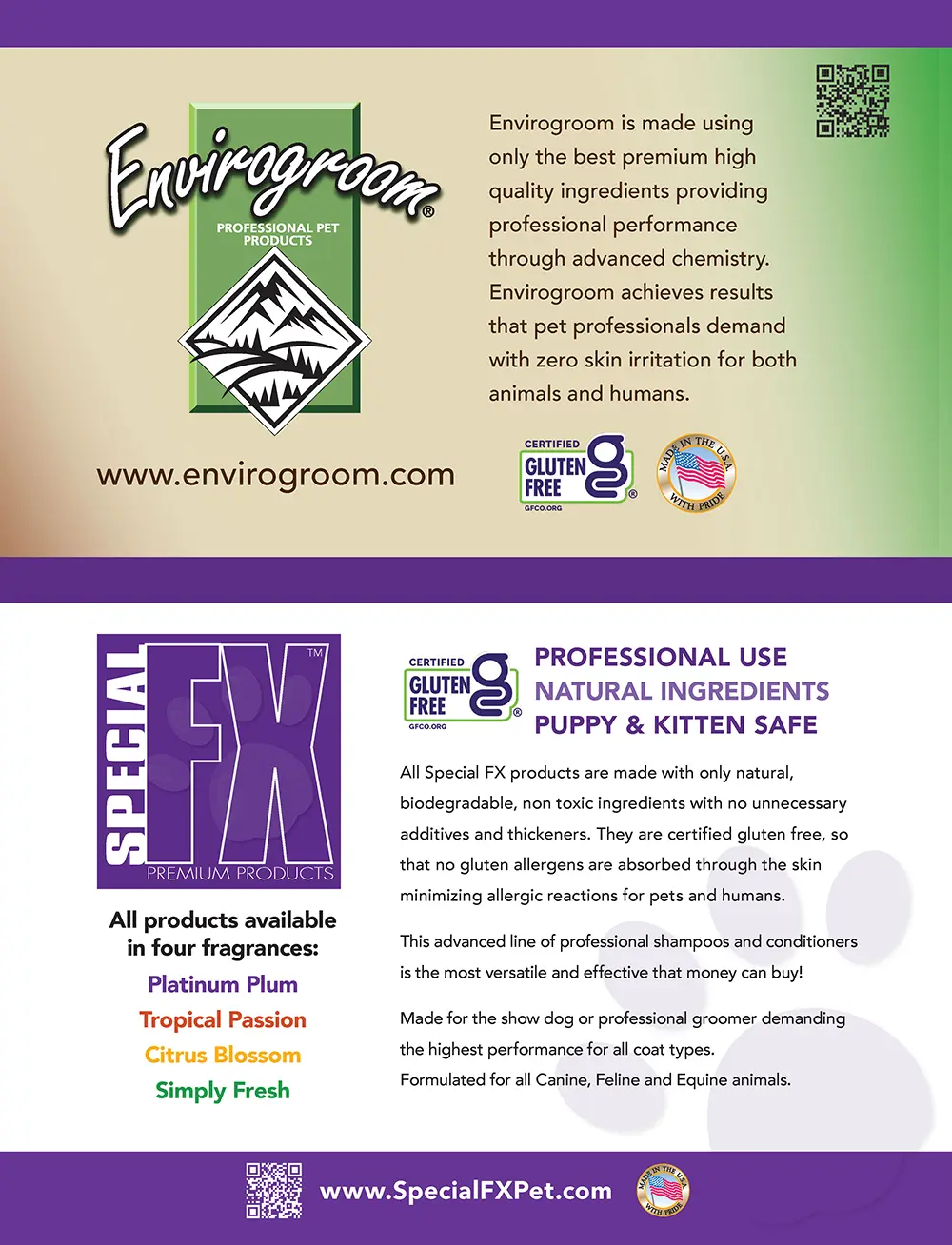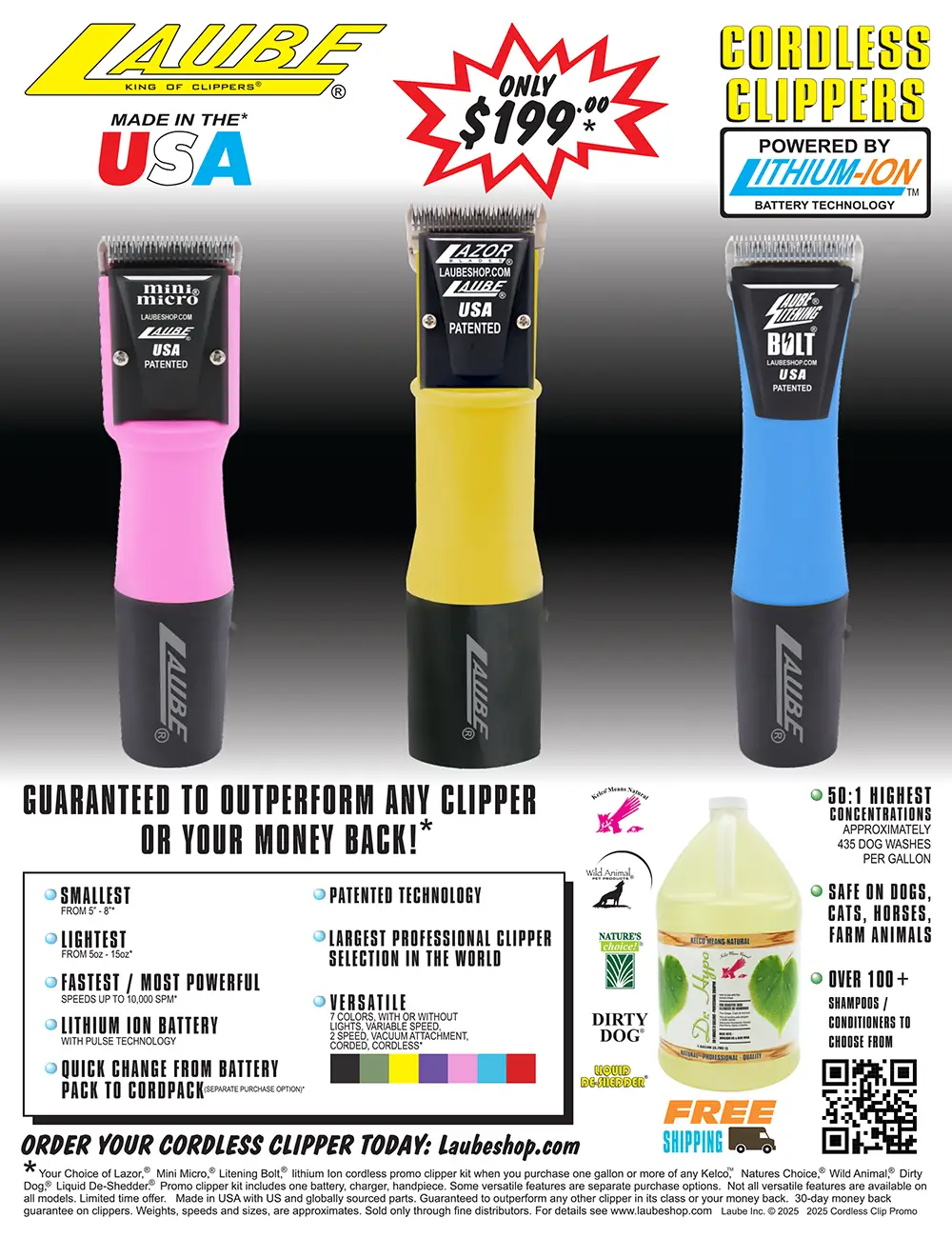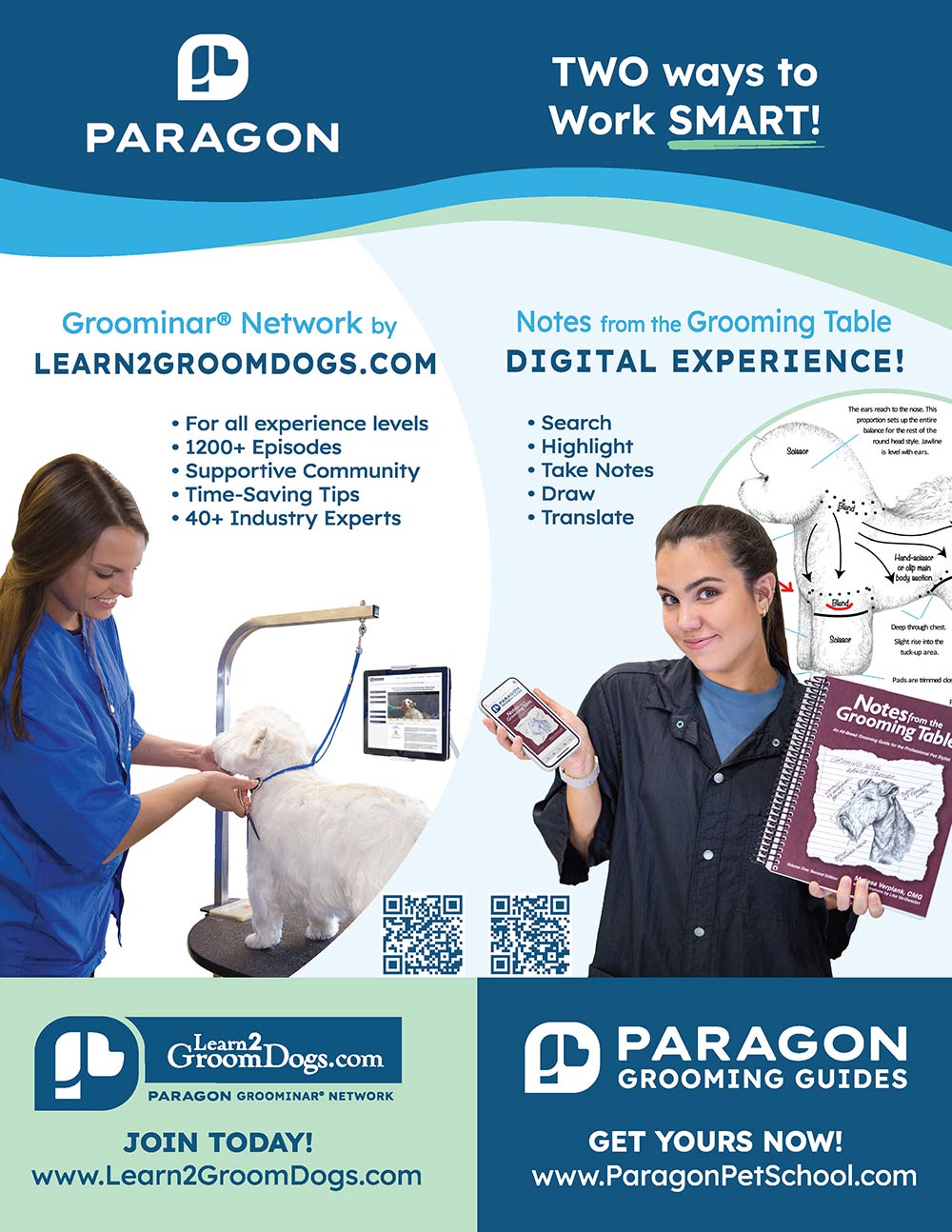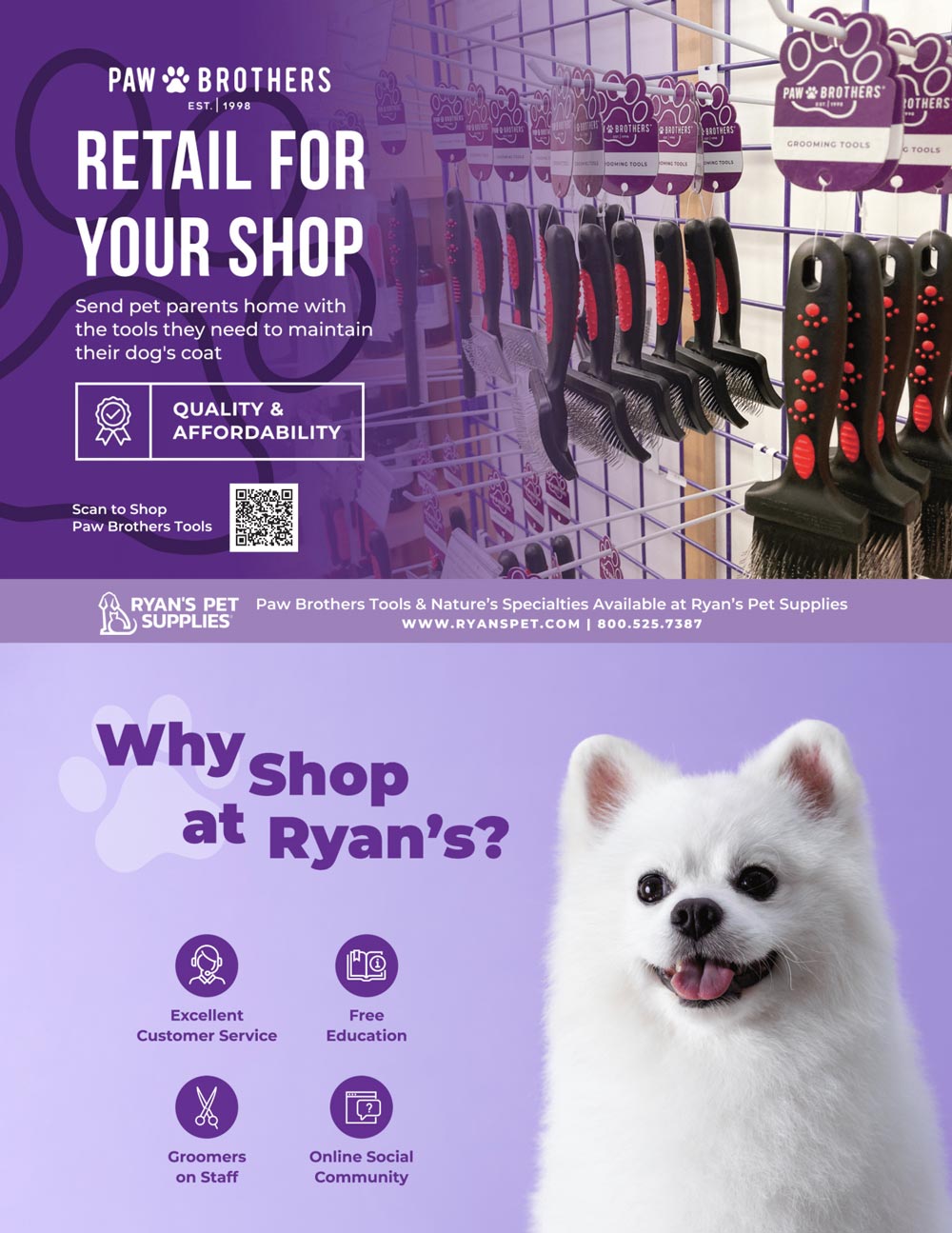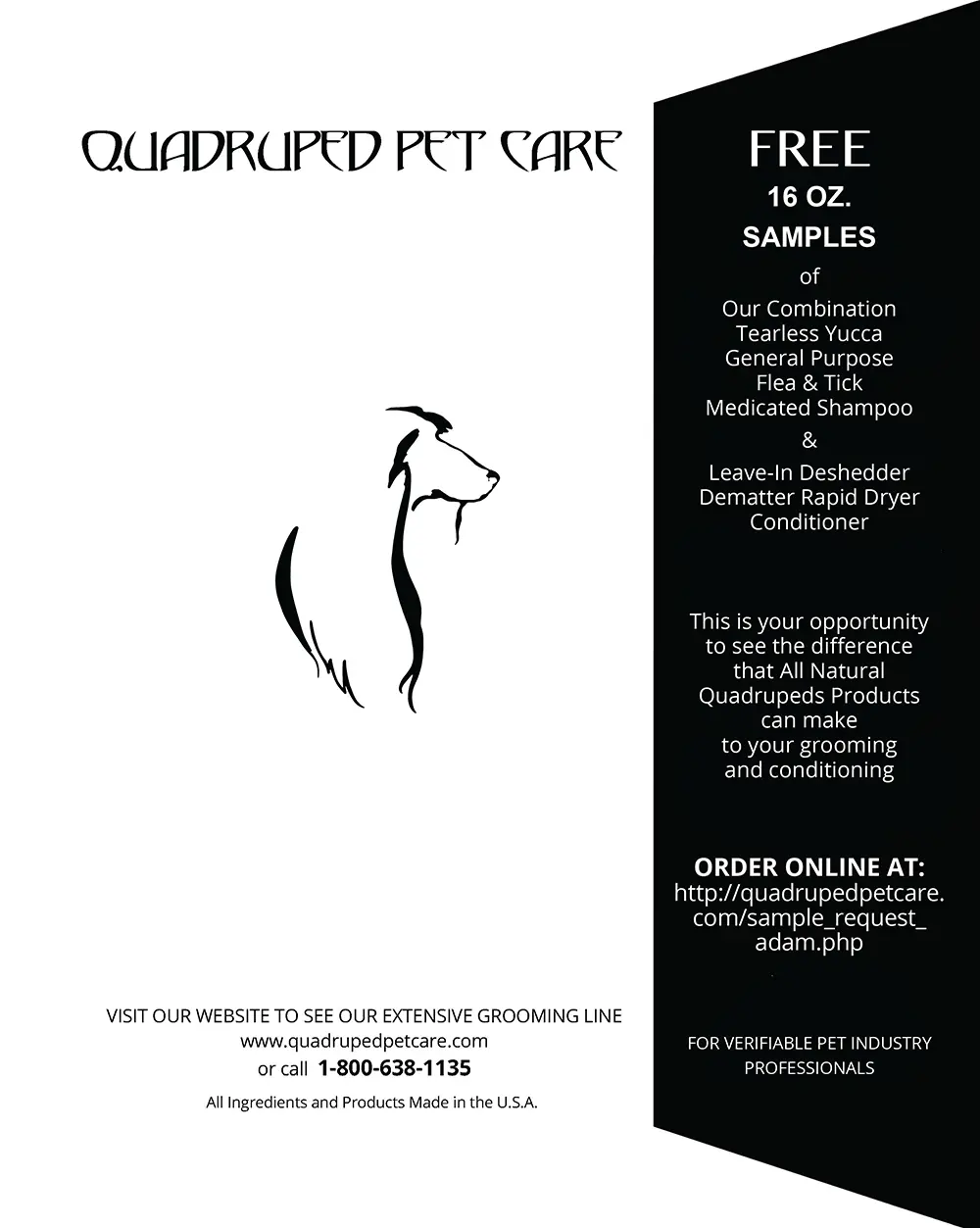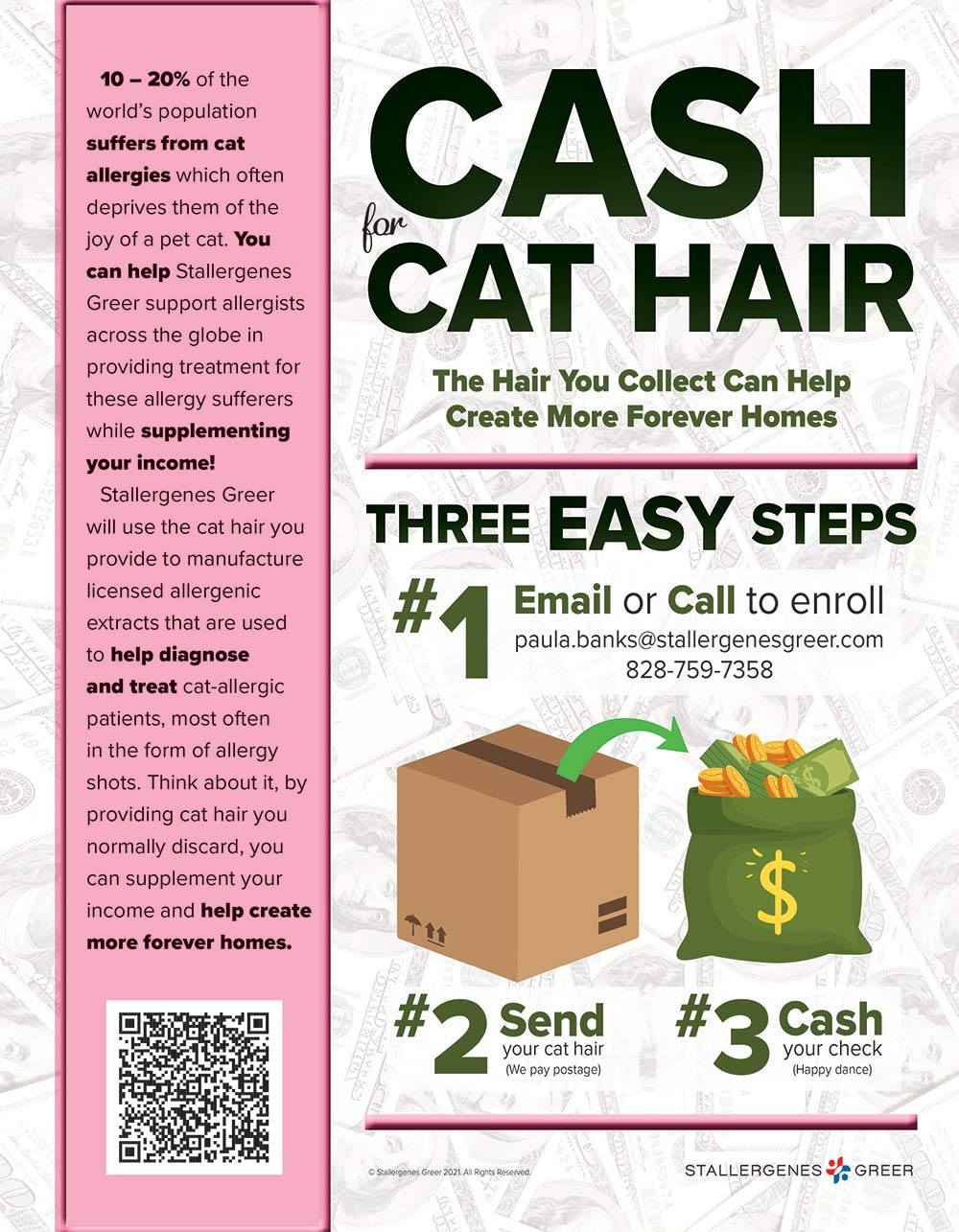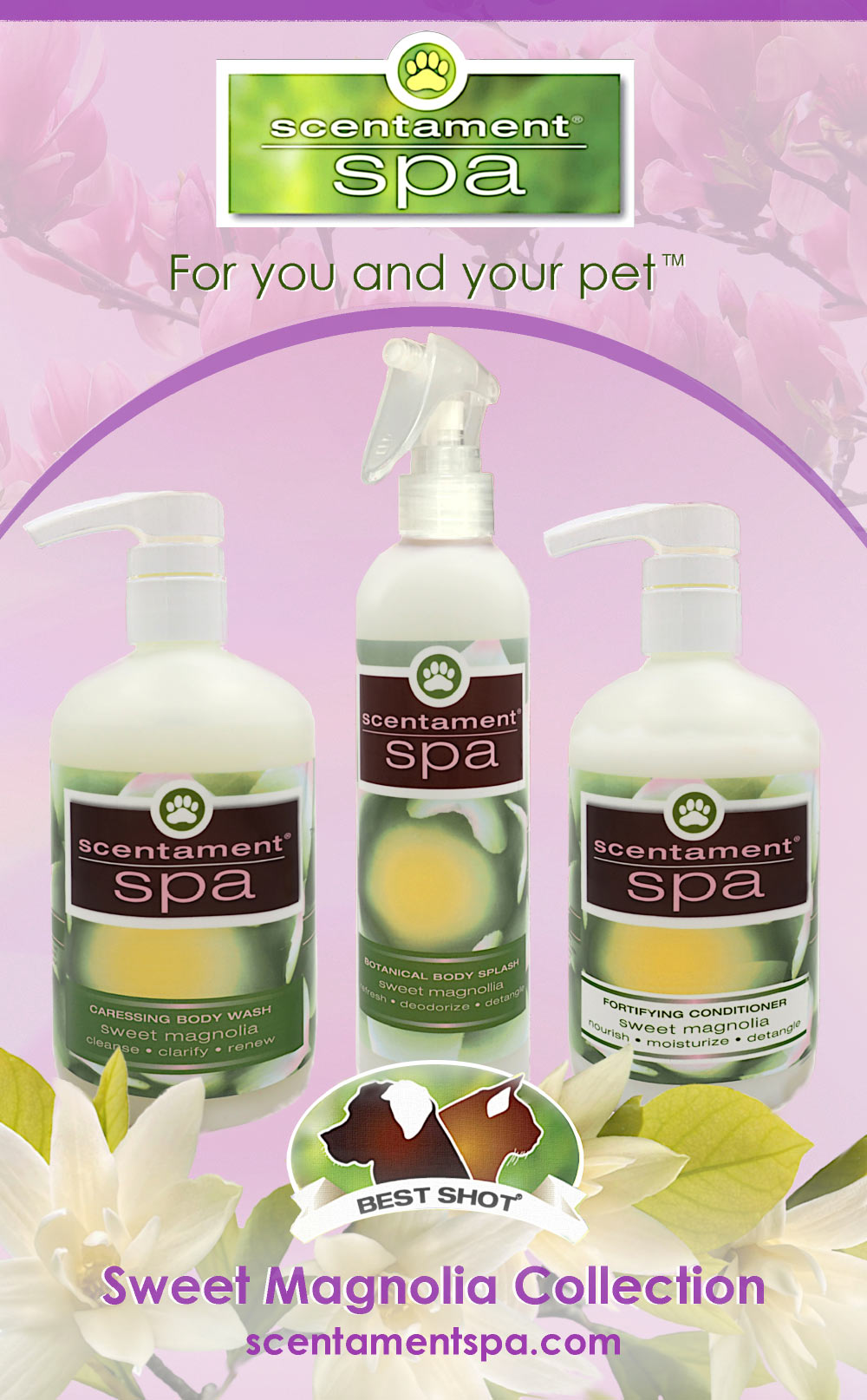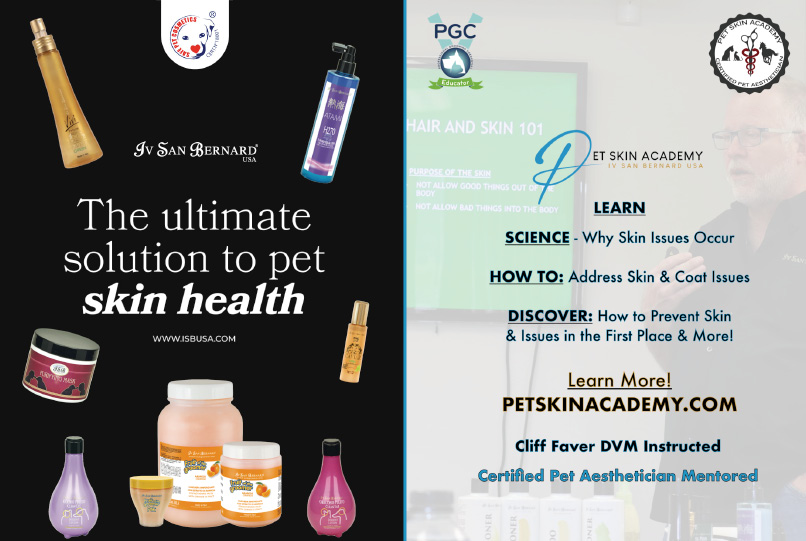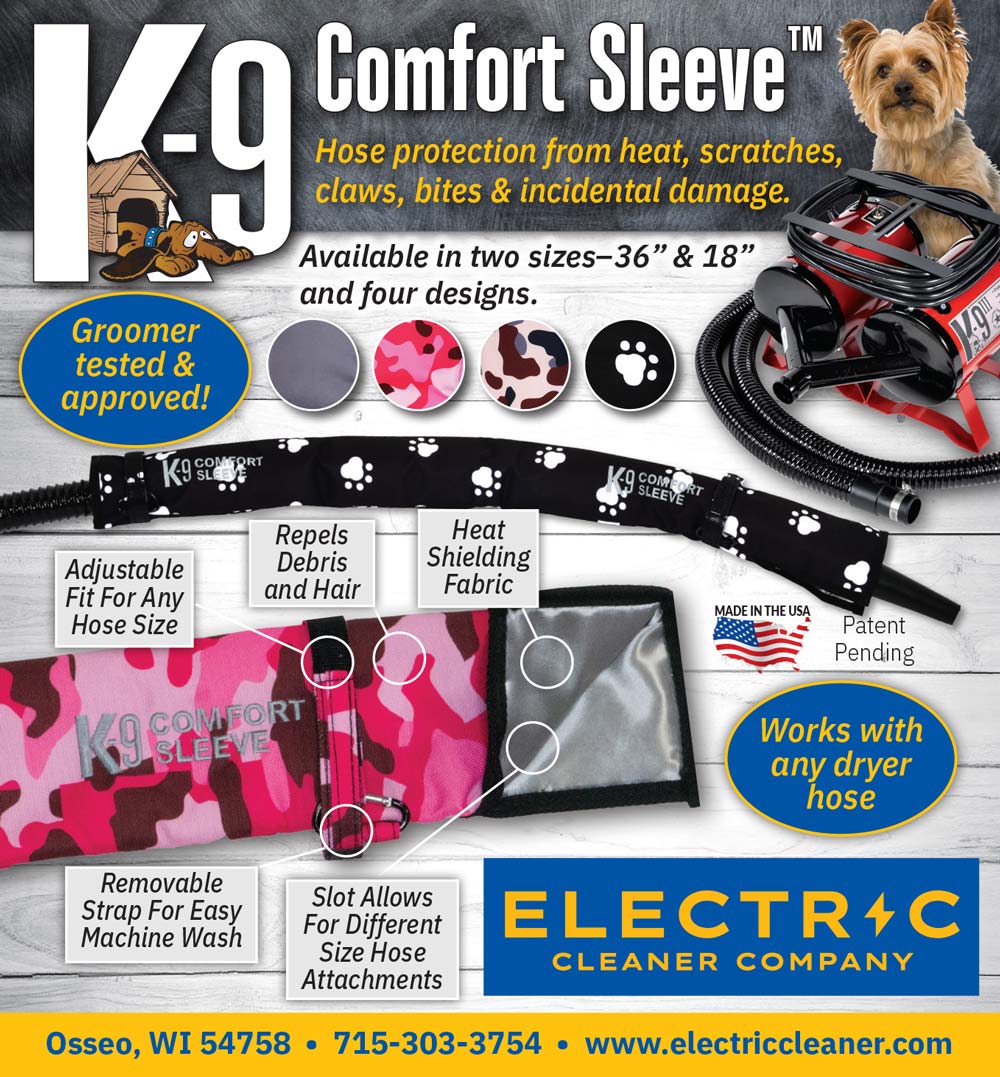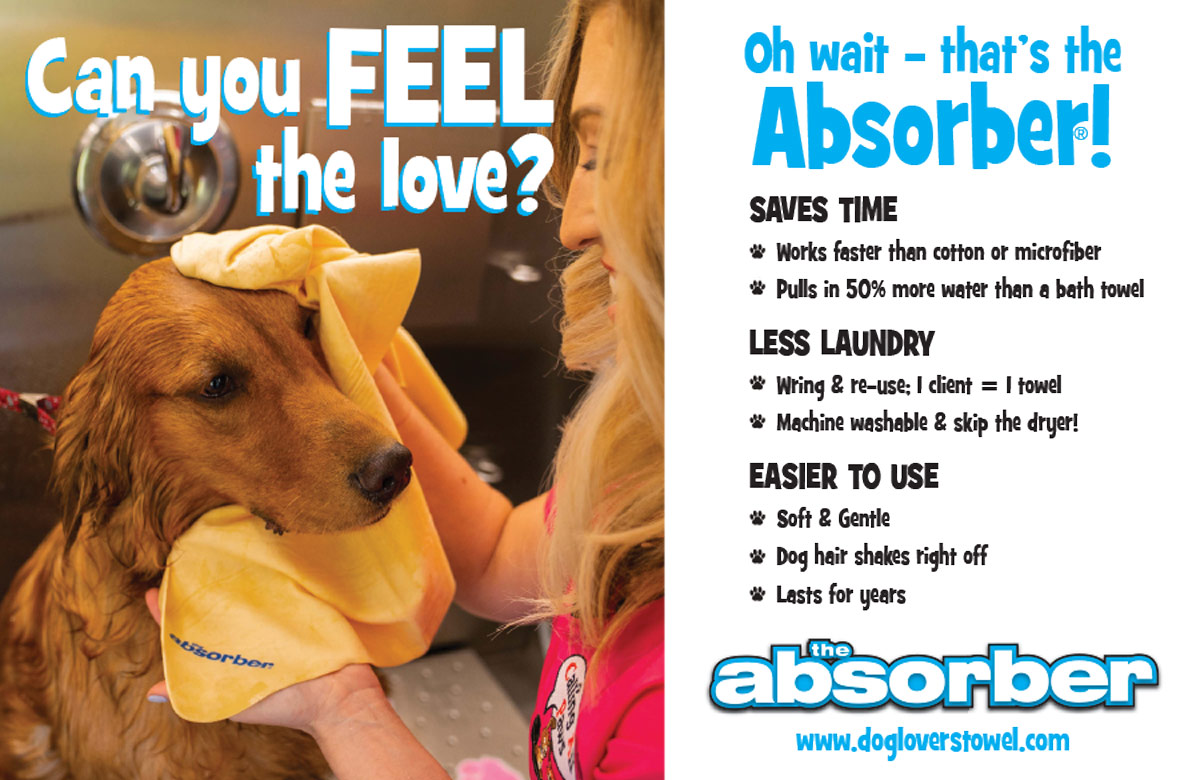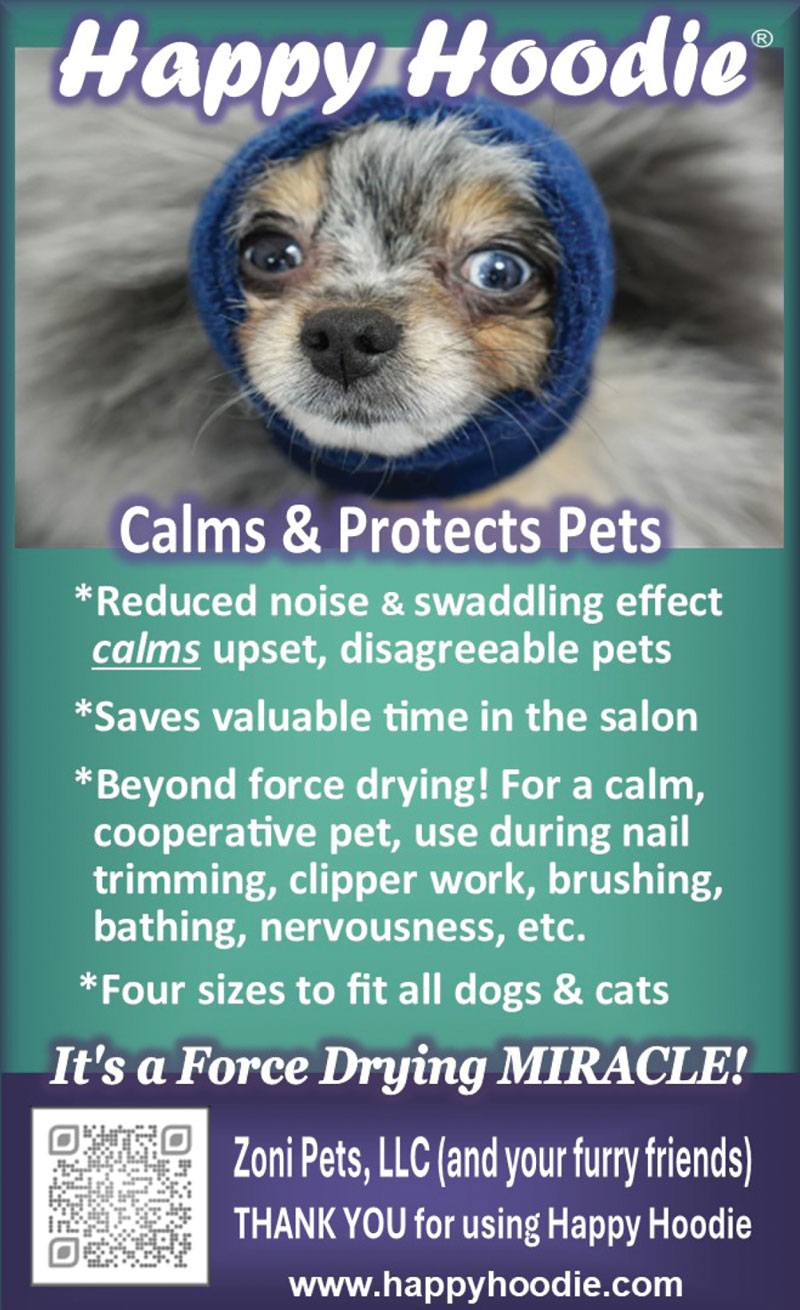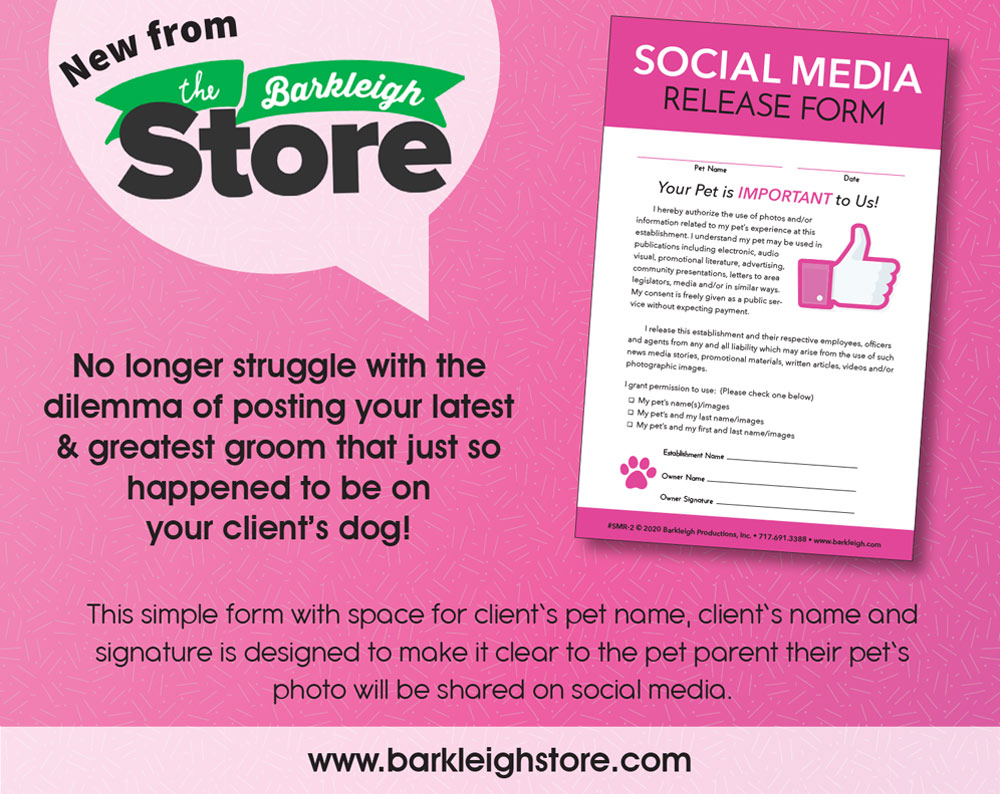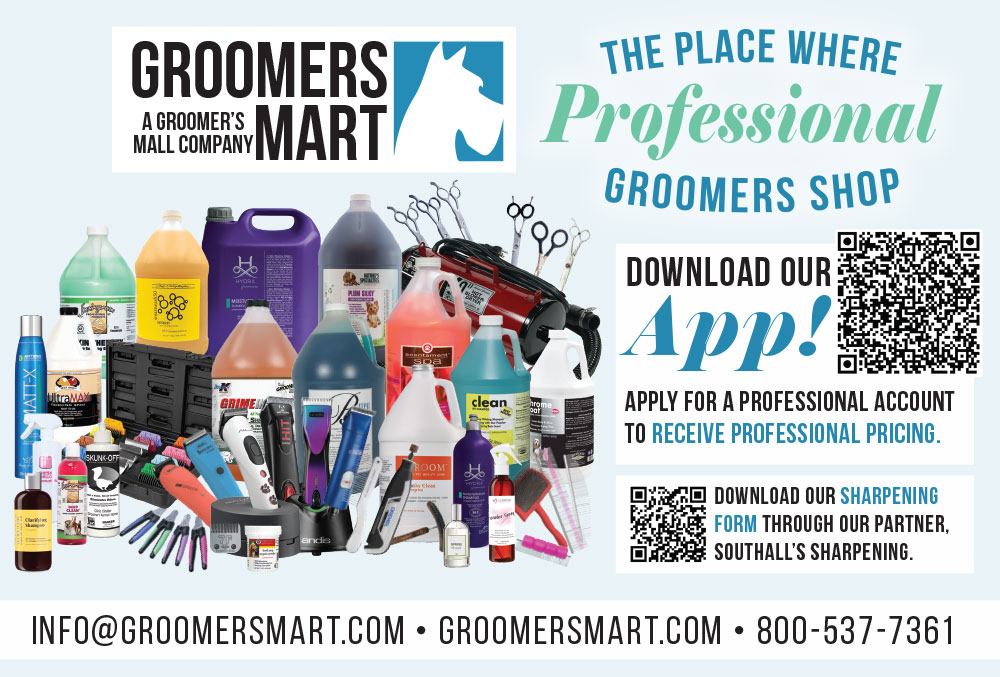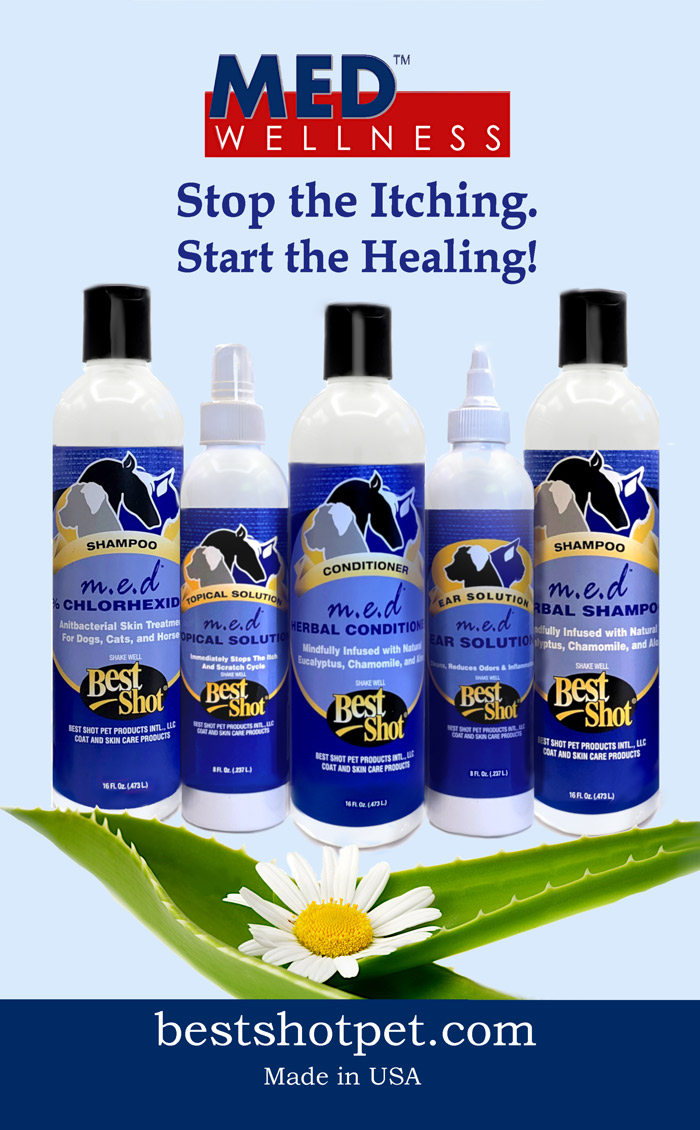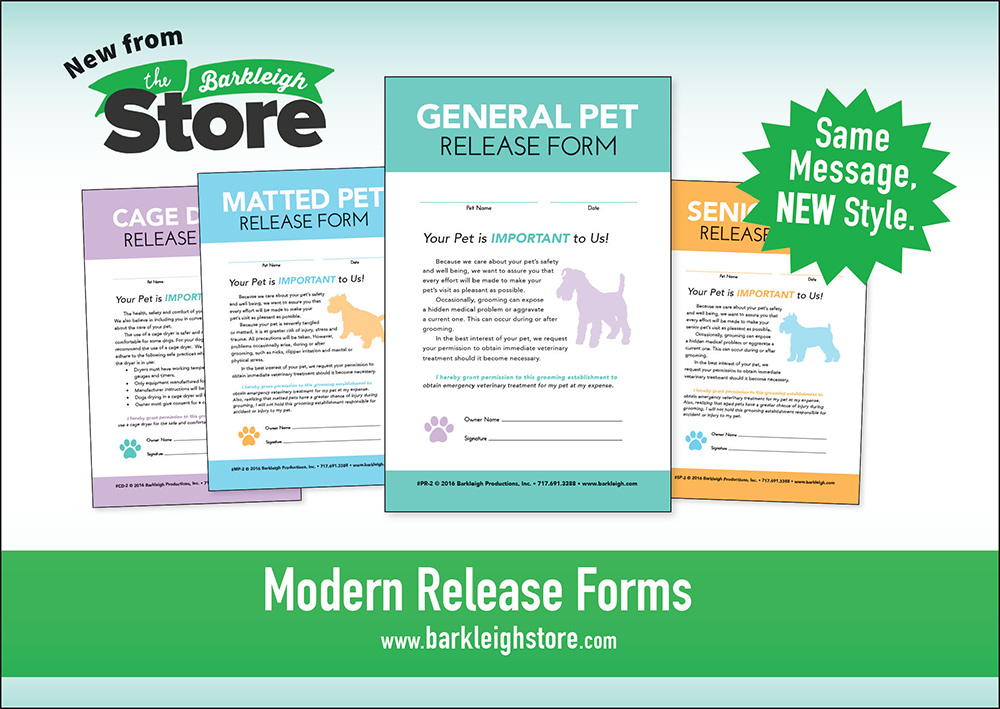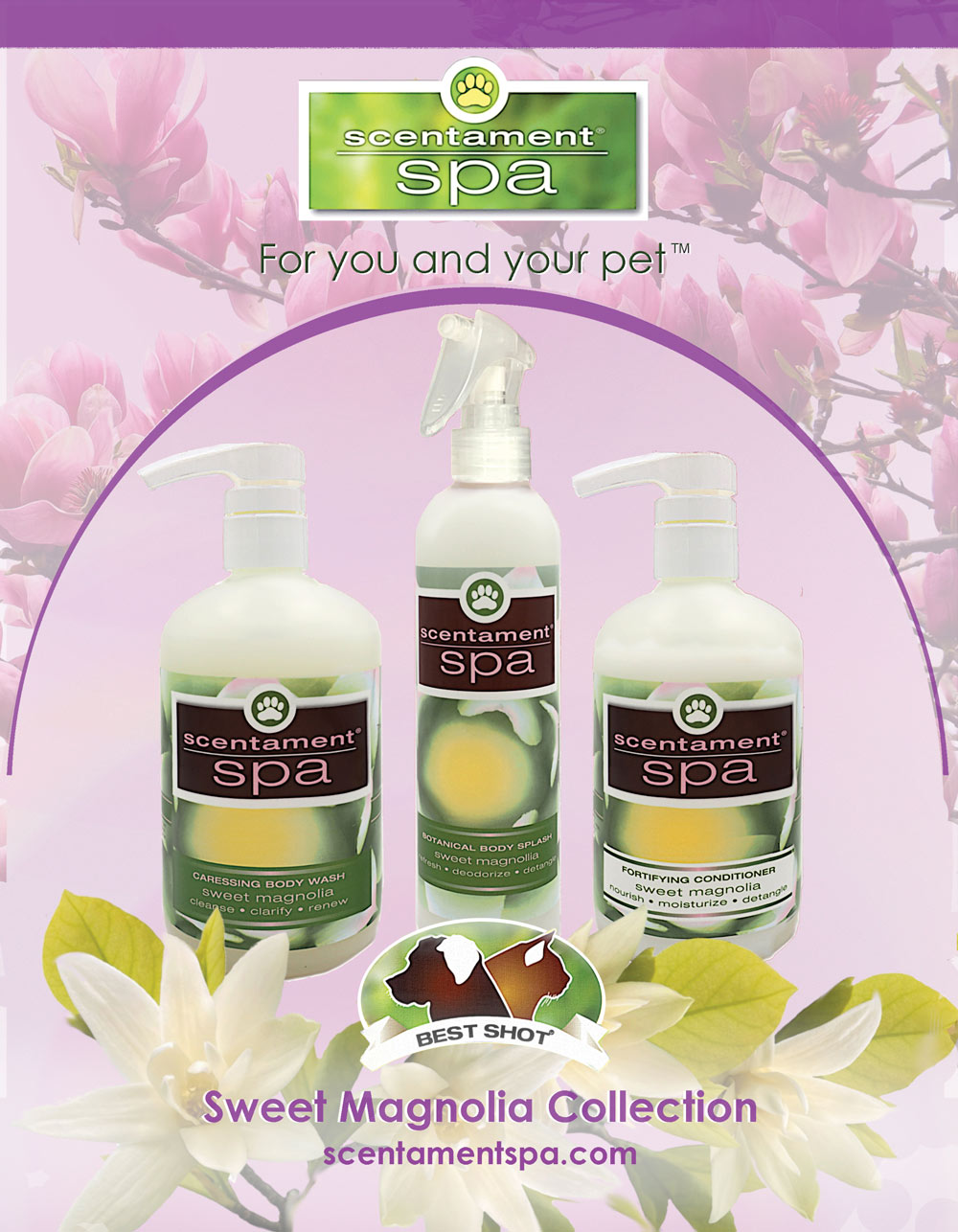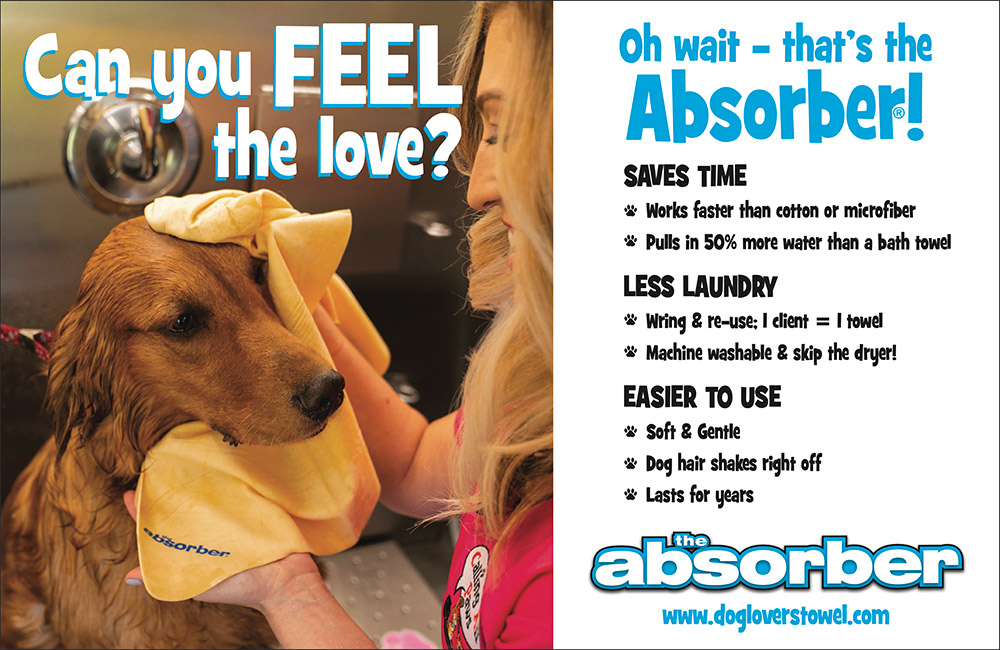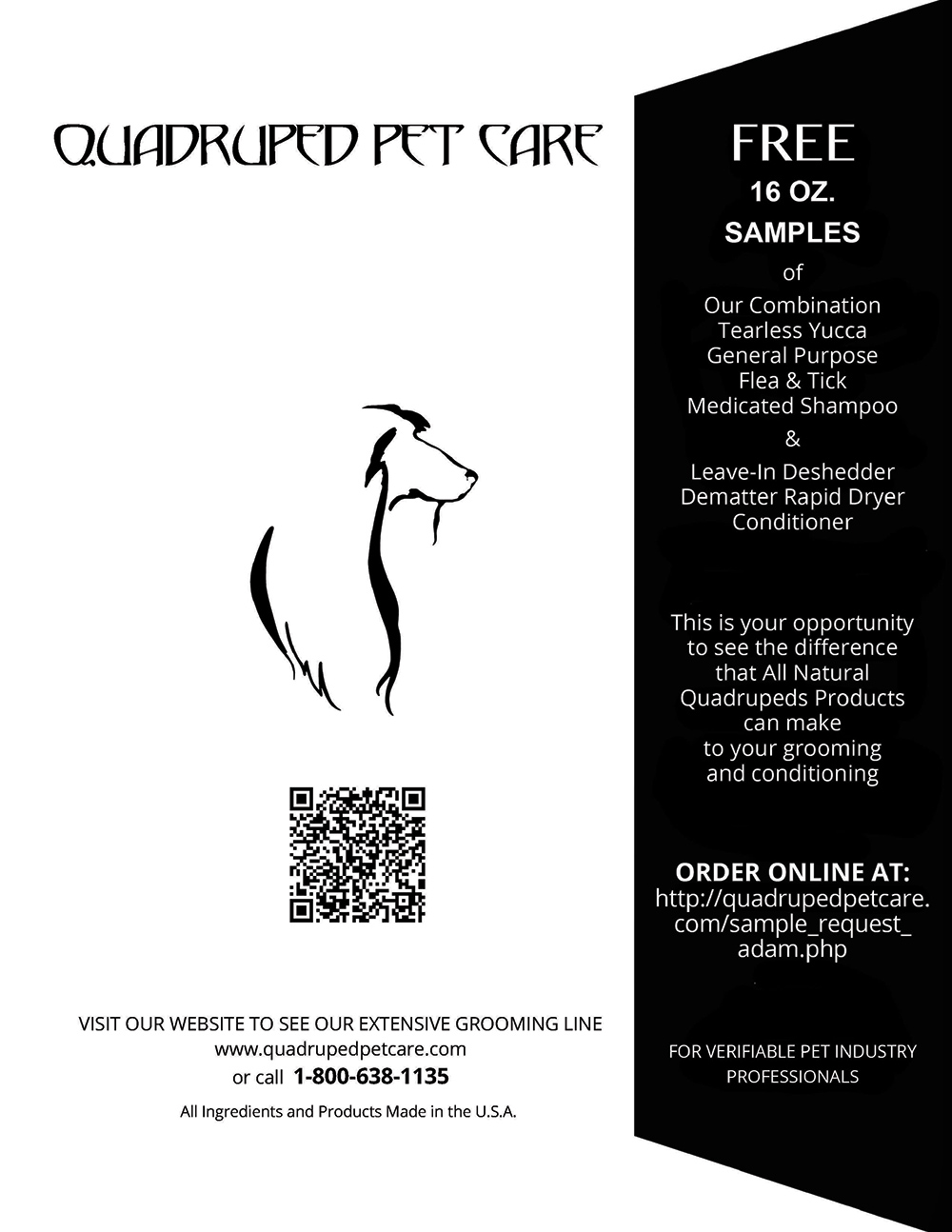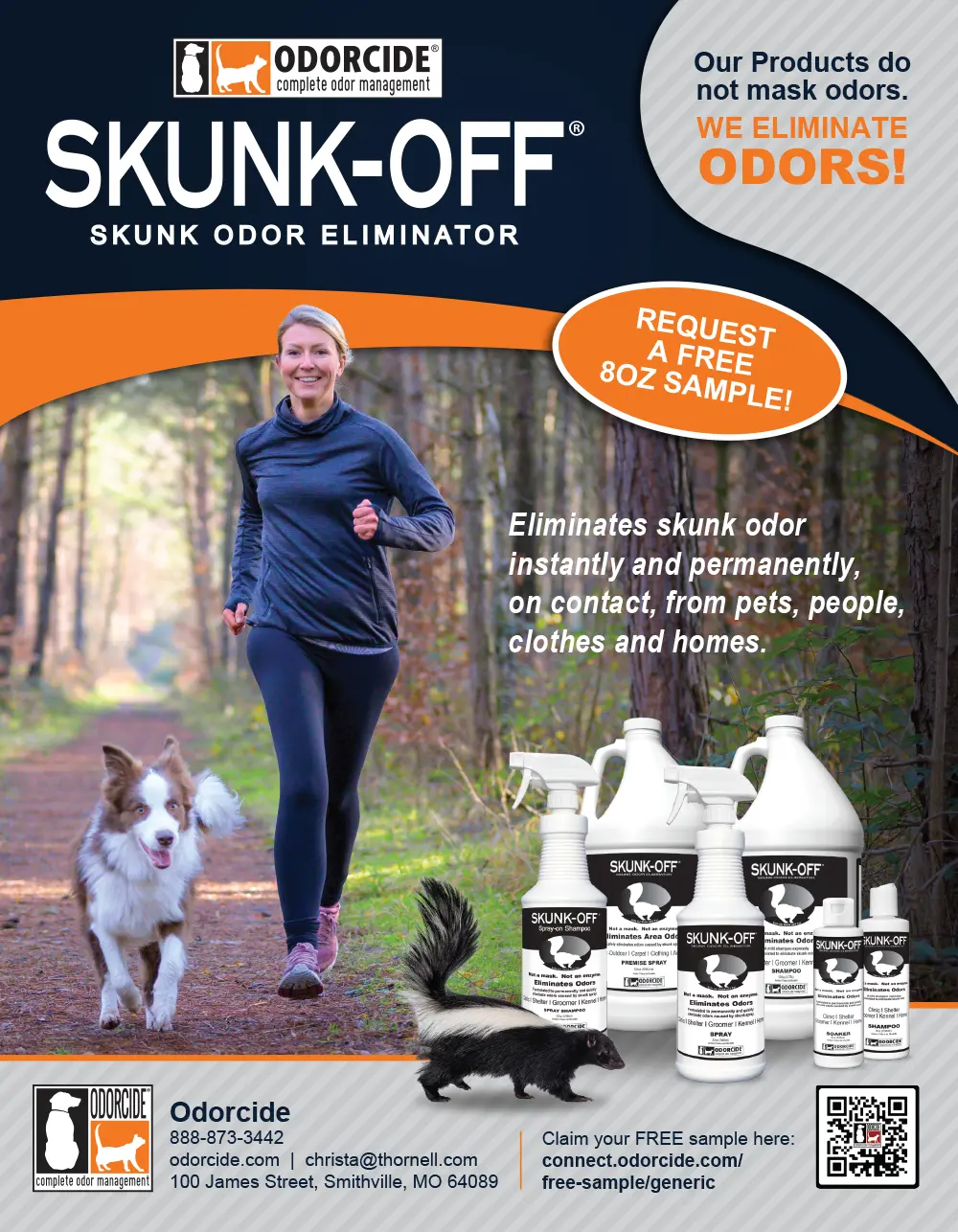Contents | April 2025
20
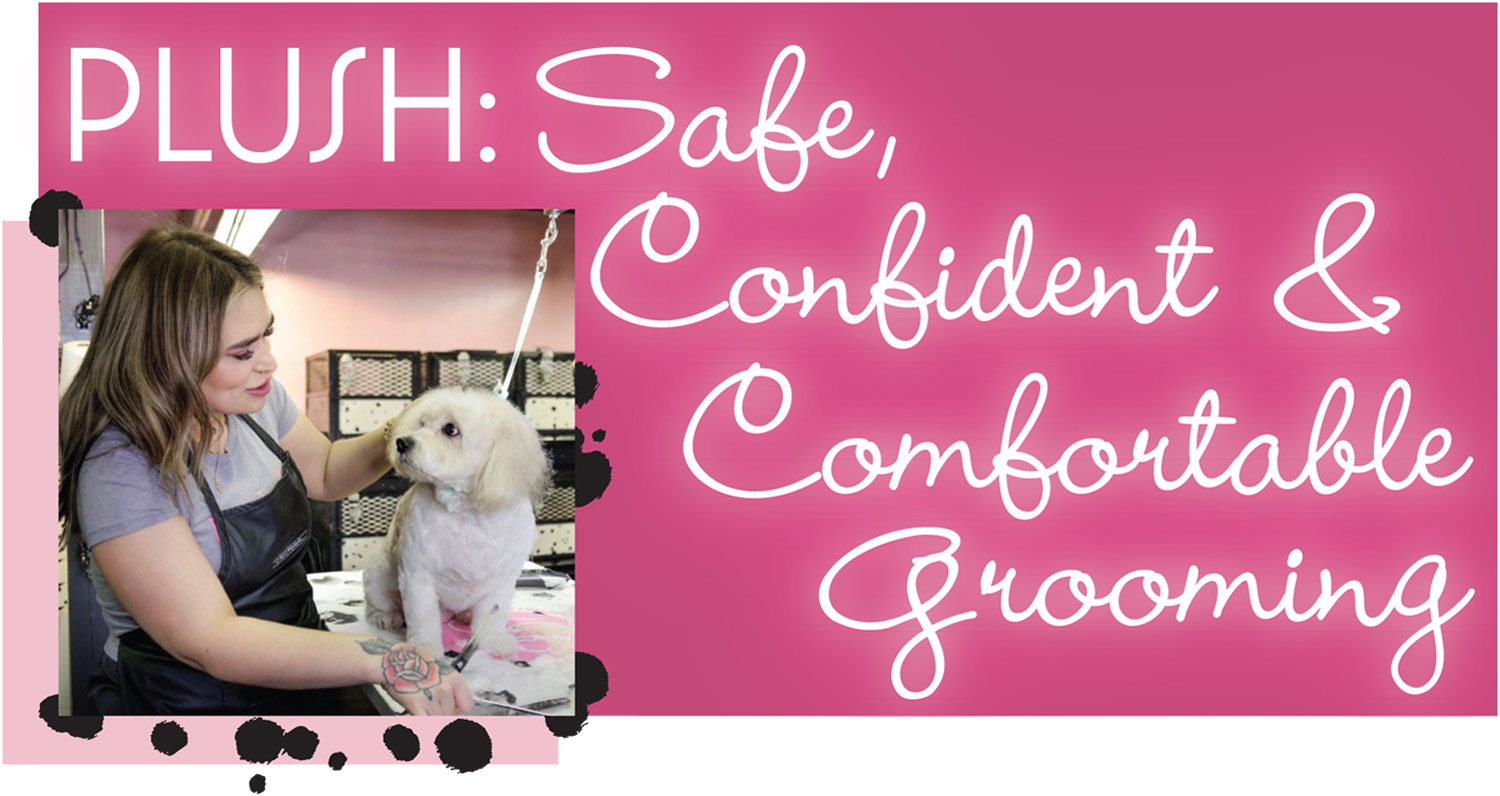
ALSO INSIDE
todd@barkleigh.com
adam@barkleigh.com
gwen@barkleigh.com
rebecca@barkleigh.com
luke@barkleigh.com
laura@barkleigh.com
brandi@barkleigh.com
carlee@barkleigh.com
evan@barkleigh.com
cassidy@barkleigh.com
allison@barkleigh.com
james@barkleigh.com
karin@barkleigh.com
britany@barkleigh.com
Daryl Conner
Lynn Paolillo
Jennifer Bishop Jenkins
Melissa Viera
ALSO INSIDE
ON THE COVER
its advertisers for their continued support.
- Andis2
- Animal Photography16
- Bandanas Unlimited31
- Barkleigh Store – Boarding Kennels23
- Barkleigh Store – Double-Coated Release Form60
- Barkleigh Store – Holistic Pet Grooming53
- Barkleigh Store – Modern Release Forms54
- Barkleigh Store – Social Media Release Form28
- Barkleigh Store – The Pet Stylist Resource Guide58
- Best Shot Pet – Med Wellness45
- Best Shot Pet – UltraMAX59
- Best Shot Pet – Scentament Spa11
- Coat Tender40
- Cosmos Bathing Systems12
- Direct Animal Products17
- Double K Industries3
- Electric Cleaner Company15
- Envirogroom | Special FX Premium Products37
- Evolution Shears9
- Groomer’s Best35
- Groomer’s Choice4
- Groomers Mart30
- Gyms For Dogs39
- Hanvey Engineering & Design41
- Happy Hoodie24
- Heart of America Grooming Show19
- IV San Bernard | Pet Skin Academy13
- Laube63
- MetroVac7
- Midmark32
- Odorcide33
- Paragon48
- Paw Brothers | Ryan’s Pet Supply64
- Pet Boarding and Daycare Expo West25
- PetBizInsurance.com8
- PetLift55
- PetQuest36
- Precision Sharp27
- Puppy Playground52
- Quadruped Pet Care29
- Ryan’s Pet Supplies | Leading Edge Grooming AcademyDigital Only
- Stallergenes Greer51
- SuperzooDigital
- The Absorber Dog Lover’s Towel18
- Wag’n Tails49
- Zolitta46

 endy was at her wit’s end. She just received this scathing review on social media:
endy was at her wit’s end. She just received this scathing review on social media:
Don’t take your dog here to be groomed! I just picked up my sweet Princess Lily and when they brought her out to me, I didn’t believe it was my dog. She was shaved bald!
My Lily is an F1b Australian Golden Doodle. The breeder told me her hair shouldn’t be cut until she was a year old. So, for her first birthday, I took her in and told the groomer that I wanted just a little trim, especially by her eyes and her butt.
When I picked her up, ALL of her hair was gone. The groomer said her hair was matted and she had to be clipped that short. No way, I brush her all the time!
They have ruined my sweet Princess Lily. Now she’s embarrassed and hiding. She’s shaking her head and the ends of her ears have blood on them.
I’m taking Lily to her veterinarian right now…then I am calling my attorney. This so-called pet stylist needs to be shut down so she can’t butcher any other precious pups!
Wendy couldn’t believe what she was reading—that’s not at all what happened. When this woman brought her dog in, Wendy checked her in, noticing the dog had never been groomed and was pelted. Wendy showed the client the matting and told her that the dog would have to clipped short all over. Even though the woman wasn’t happy, she agreed.
When she picked up her dog, Lily’s owner caused a huge scene. She screamed when she saw her dog and started to cry. She denied that she gave Wendy permission to clip the hair off her “rare” dog. She kept shrieking that Wendy ruined her dog, so now she would ruin Wendy. She refused to pay, took her dog and left.
Unfortunately, Wendy is not alone. Every day we see posts on social media bashing groomers and accusing them of injuring pets. What could Wendy, and others, have done to prevent these damaging reviews of their business?
In today’s world, groomers have to plan for their safety and put procedures in place to safeguard their livelihood. Protecting yourself starts during your first contact with a potential client.


Good communication between the owner and stylist is vital for a positive outcome.


When a client—especially a first-time one—arrives for their appointment, have the owner present when you check in the pet. As you examine the pet, point out and document any problems like matting or other issues, such as ear odor or inflammation, feces stuck to the rear end, fleas, etc.
Good communication between the owner and stylist is vital for a positive outcome. Ask them how they want their pet groomed and clearly explain if it is, or is not, possible. Take the time to discuss in detail what will be done during the grooming process.
Matted pets are one of the most frequent issue groomers are presented with. Have before and after photos showing matted pet clip-downs. If possible, have a piece of pelted hair to show owners as well. Point out how the top of the coat can look brushed out but underneath it is a solid mat.
Make sure the owner understands what you will be doing to their pet. Have every owner sign a consent/release form. If they refuse, don’t groom the pet. There is a consent/release form for nearly every situation: General Pet Release, Matted Pet, Senior Pet, Double-Coated Pet, Creative Color, Pet Safety, Cat Grooming, Mobile Salon, Social Media, Cage Dryer and more. These can be purchased at www.barkleighstore.com or you can make your own.
In addition to having signed releases for every pet you groom, it’s imperative to have insurance coverage and also to take photos and videos to protect yourself. If the pet has any skin abrasions or issues, growths, ear redness or odor—anything out of the ordinary—document it. If possible, video the entire groom. That is irrefutable proof of everything that happened during the grooming process. Also have cameras inside and outside your salon or mobile unit to protect yourself.
Rich, a groomer who has a salon about 20 miles from Wendy, recently had an incident that could have had a totally different outcome if he had not been prepared…
Luckily, Rich has cameras inside as well as outside of his salon. When he viewed the footage of the day, he could clearly see that the dog was not limping when it left the salon. He saw the owner open the back of his SUV and tell the dog to “load up.” The dog attempted to jump in but didn’t make it. It fell to the pavement with a sharp yelp. The owner quickly picked him up, tossed him in the car and left.
After Rich viewed the videos, he called the owner, related what he saw, and calmly invited the owner to come to the salon and view the footage. The owner quickly hung up and Rich never heard from him again.
If Wendy had taken photos or a video of Princess Lily’s groom, and had a signed release, Lily’s owner might have been less likely to leave the bad review. And, even if she had, Wendy would have had proof of the condition of the dog when it came into her salon, proof that the owner gave consent and proof that the dog was uninjured when it left the salon.
Do yourself a big favor and be like Rich—protect yourself!



 ntibiotics have long been a game-changer in medicine. They help both humans and pets combat infections, making once-deadly diseases manageable. However, the overuse and misuse of antibiotics have given rise to a critical and growing problem: drug-resistant bacteria, also known as “super bugs.” As a groomer, it’s essential to understand the risks associated with these bacteria and how to protect yourself, your clients and their pets from potential infections.
ntibiotics have long been a game-changer in medicine. They help both humans and pets combat infections, making once-deadly diseases manageable. However, the overuse and misuse of antibiotics have given rise to a critical and growing problem: drug-resistant bacteria, also known as “super bugs.” As a groomer, it’s essential to understand the risks associated with these bacteria and how to protect yourself, your clients and their pets from potential infections.The Evolution of Super Bugs
Many veterinarians have a preferred “go-to” antibiotic that they prescribe frequently. Over time, this repeated exposure encourages bacteria to mutate and develop resistance to that particular class of antibiotics. As resistance builds, doctors are left with fewer effective treatment options, leading to the emergence of these “super bugs.”
As a groomer, you may encounter dogs and cats with MRSP infections without even realizing it. The bacteria look like any other skin infection, making it difficult to identify without a veterinary culture and sensitivity test. These tests are essential for determining which antibiotics, if any, will work against the specific strain of bacteria.
Groomers are at a higher risk of exposure to these bacteria due to their close contact with multiple pets daily. Here are some key points to understand about the risks:
- High-Risk Pets: Pets on long-term antibiotics or with compromised immune systems are more likely to harbor drug-resistant bacteria.
- Frequent Exposure: Groomers who work with pets suffering from chronic skin issues are more likely to come into contact with MRSP.
- Human Risk: Up to 4% of people working with pets, including groomers, may contract MRSP.
- Hidden Threat: Many groomers may have already been exposed to MRSP without knowing it.
- Personal Protective Equipment (PPE): Always wear gloves, eye protection and face masks when handling pets with visible skin infections. Water sprays can aerosolize bacteria, making it easier to inhale them or spread them to surfaces.
- Clean and Disinfect Equipment: Your grooming tools—such as scissors, brushes, clippers and recirculation systems—can become breeding grounds for bacteria if not properly cleaned. Disinfect all equipment between each pet to prevent cross-contamination.
- Schedule Infected Pets Last: If you know a pet has a skin infection, try to schedule them as the last appointment of the day. This minimizes the risk of spreading bacteria to other pets and gives you time to do a thorough cleaning afterward.
- Maintain Clean Workspaces: Cleanliness is critical in preventing the spread of super bugs. Disinfect grooming tables, tubs, cages, towels and any other surfaces that come into contact with pets. A good rule of thumb is to clean after every pet.
- Red, inflamed skin
- Pustules or boils
- Hair loss around the infected area
- Itching and irritation
If you notice a pet with these symptoms, advise the owner to consult their veterinarian for a culture and sensitivity test. Identifying the bacteria early can prevent the spread and ensure appropriate treatment.
Encourage pet owners to prioritize testing, especially if their pet has a recurring skin infection. While the upfront cost may be higher, it can save time, money and frustration in the long run by ensuring the right treatment is used from the start.
“Super Bug” Key Takeaways
- Protect Yourself: Always use PPE when dealing with infected pets to minimize your risk.
- Clean Thoroughly: Disinfect all tools and surfaces after each pet to prevent the spread of bacteria.
- Promote Testing: Encourage pet owners to invest in culture and sensitivity tests to ensure effective treatment.
- Stay Informed: Keep up to date on the latest information about drug-resistant bacteria and best practices for preventing their spread.
The Bigger Picture: Public Health Implications
Super bugs like MRSP are a growing concern in both human and veterinary medicine. As a groomer, understanding the risks and taking appropriate precautions can help protect you and the pets in your care. By implementing proper hygiene practices, promoting responsible antibiotic use and staying informed, you can reduce the risk of spreading drug-resistant bacteria and ensure a safer environment for everyone involved.
Dr. Cliff Faver graduated with a BS in Biology/BA in Chemistry before getting a Veterinary degree in 1987. He is the past owner of Animal Health Services in Cave Creek, Arizona and now the US distributor for Iv San Bernard products, teaches the ISB Pet Aesthetician Certification program, and speaks internationally on hair and skin. His passion is to merge groomers and veterinarians to aid in helping and healing pets. He is also a member of AVMA, AAHA, AZVMA, Board member with Burbank Kennel Club, and has served on Novartis Lead Committee, Hill’s International Global Veterinary Board, and a Veterinary Management Group.
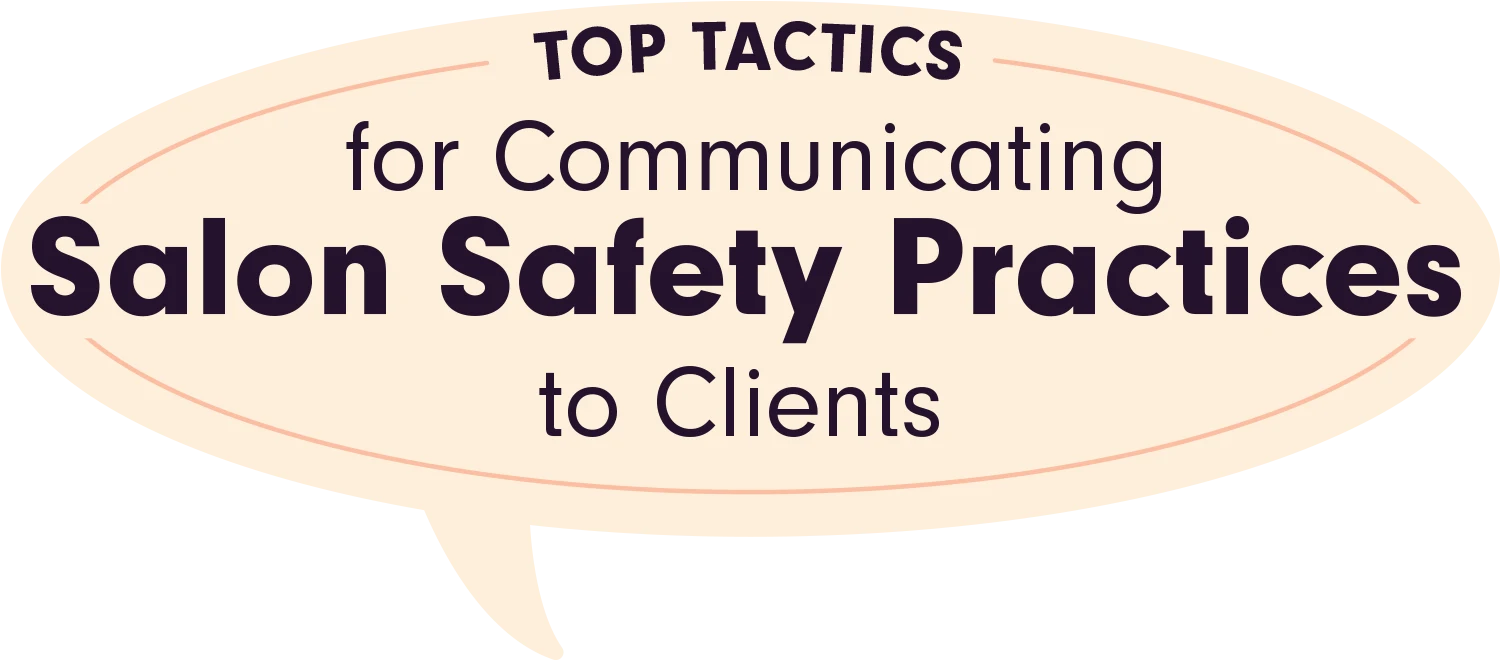


 hen it comes to pet grooming, safety is a cornerstone of the client-groomer relationship. Pet parents want to feel confident that their beloved companions are in good hands, and groomers must prioritize transparency and trust. Communicating safety measures effectively not only builds client confidence, but also fosters long-term loyalty and mutual respect. Here’s how groomers can communicate their safety practices in a professional and engaging manner.
hen it comes to pet grooming, safety is a cornerstone of the client-groomer relationship. Pet parents want to feel confident that their beloved companions are in good hands, and groomers must prioritize transparency and trust. Communicating safety measures effectively not only builds client confidence, but also fosters long-term loyalty and mutual respect. Here’s how groomers can communicate their safety practices in a professional and engaging manner.
For example, explain how you assess each pet’s needs before starting, including a physical check for skin conditions, matting or sensitivities. Share how these evaluations inform your grooming approach, such as choosing hypoallergenic shampoos or adjusting clippers to prevent irritation. This demonstrates that safety is integral to every step of your service.
This is the interaction that they’re going to remember during the grooming process until they pick up their pet. You can use this step to ease their mind and gain professional trust.
Also explain how your training ensures you’re educated in the latest grooming techniques and safety practices. For instance, you might say: “Our team regularly attends workshops on pet safety, including CPR for animals, to ensure we’re prepared for any situation.” Such statements show your dedication to safety while positioning you as a leader in the field.
- How you sanitize equipment between pets
- The precautions you take for senior pets or those with health issues
- Your policy for managing anxious or aggressive animals
Open transparency sets the pet up for future success and provides a chance to build trust with a client that understands the pet’s needs.

If a pet becomes stressed during grooming, explain the situation to the owner. For example: “Max was a bit anxious during his nail trim, so we took extra breaks to keep him calm. While we couldn’t complete the trim today, I recommend a gradual desensitization plan to help him feel more comfortable.”
This approach reassures clients that their pet’s wellbeing is your priority, even when it means adjusting expectations. Forcing pets through may sound like a good idea to complete the service for the customer, but in reality it is not safe, and the hero mentality is not worth it in the end. Open transparency sets the pet up for future success and provides a chance to build trust with a client that understands the pet’s needs.
- A video demonstrating how you sanitize grooming tools
- Photos of your pet-friendly work environment
- Testimonials from happy clients emphasizing the care you provided
This approach validates their feelings while demonstrating your commitment to finding solutions. Not every concern needs to be met with a defensive approach—oftentimes in my career when I’ve been receptive of concerns, the client is more willing to hear the solutions.
Listening and acting on feedback demonstrates your dedication to exceptional care.
Communicating safety to pet grooming clients is not just about listing protocols; it’s about building trust through consistent, transparent and empathetic communication. By educating clients, showcasing your expertise and addressing concerns proactively, you can create a safe and welcoming environment that fosters long-term relationships with both pets and their owners.
In a business where trust is everything, prioritizing safety communication is a win for everyone involved. You’ll find that with these tactics you will earn the trust your professionalism deserves and have happier client relationships.
Plush: Safe,
& Comfortable
Photos by Elaine Photography & Groom Haüs
Photos by Elaine Photography & Groom Haüs
 n 2020, a couple months before COVID, Sarah Drouin opened Plush, a luxurious members-only dog grooming salon located in Claymont, Delaware. While the timing wound up being a bit scary, it was a decision that Sarah had worked towards for more than a decade. Plush has evolved and prospered over the years, so she can safely say she has lived out her dream.
n 2020, a couple months before COVID, Sarah Drouin opened Plush, a luxurious members-only dog grooming salon located in Claymont, Delaware. While the timing wound up being a bit scary, it was a decision that Sarah had worked towards for more than a decade. Plush has evolved and prospered over the years, so she can safely say she has lived out her dream.
Today, Sarah, a National Certified Master Groomer through NDGAA, has more than 15 years of experience as an award-winning stylist and is Pet Tech CPR certified.
“I’ve had dogs my whole life, often many dogs at one time, so my love for dogs has always been there,” she shares. “One day I was watching [The Dog Whisperer] Cesar Millan, and I could see this was someone who was very special and unique, and helping dogs that people say couldn’t be helped.”
Sarah felt she wanted to do something similar, and started down that path by going to school to become a dog trainer and obedient instructor—the closest thing she could find to what Millan was doing.
“I really love the outcome of training a dog, and I knew if I was going to open a facility, I should have grooming as well,” she recalls. “But I knew I needed to learn how to do that because I didn’t want to be an owner who didn’t understand what was going on.”
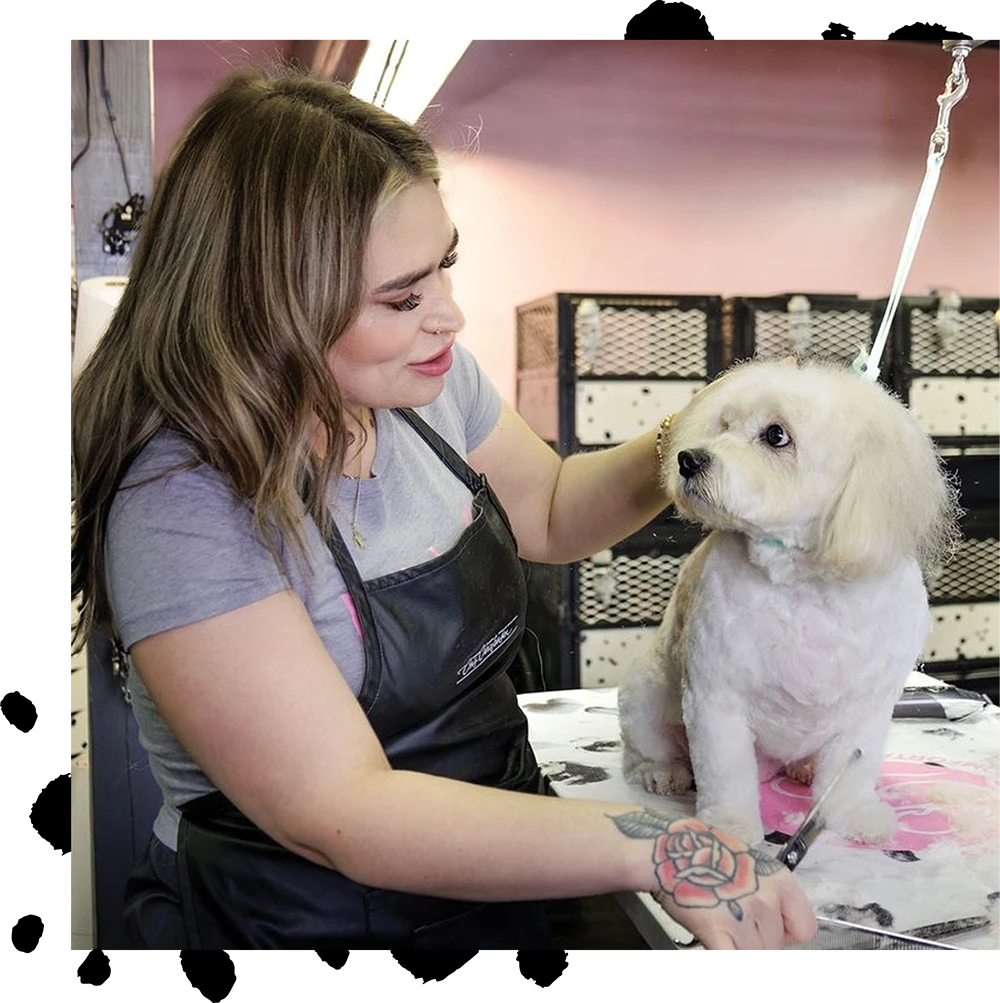
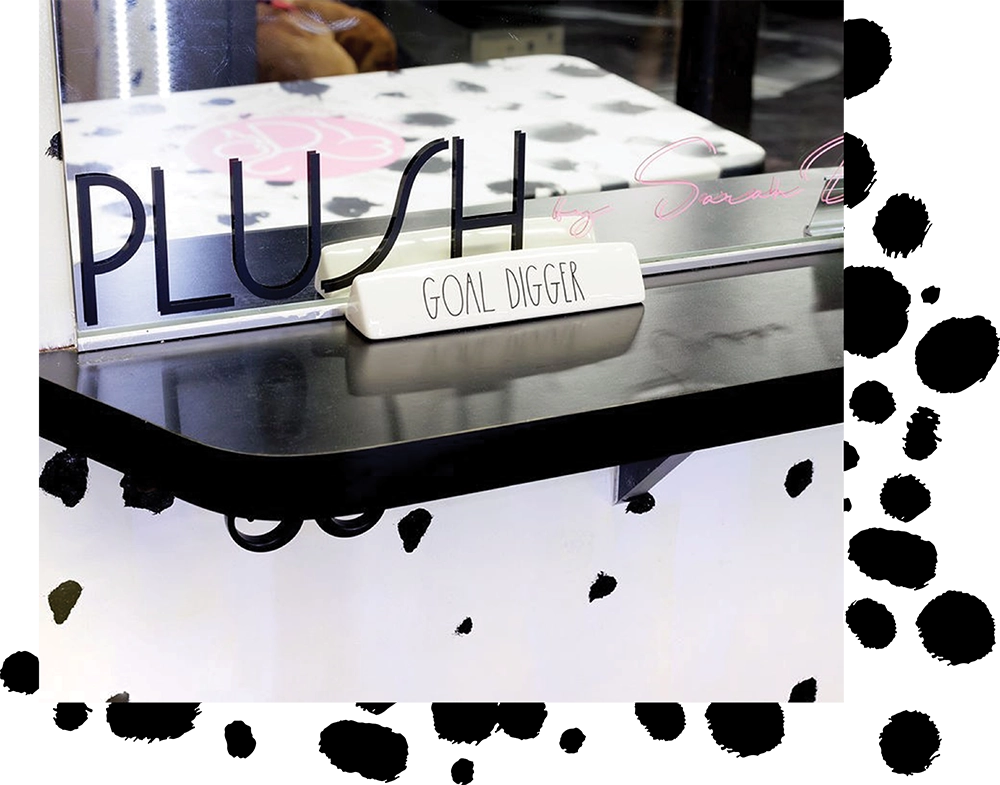
“I didn’t want to be one of these people who worked at a lot of different places, but unfortunately that’s what happened,” Sarah explains. “But I believe that journey was for a reason because it taught me what I like, what I don’t like, what works, and it molded my brain that what I really wanted to do was not what anyone else was doing.
“I wanted to be the best groomer for the dogs and my clients that I could possibly be, and whatever that was, is what I was aiming for,” she adds.
Once Sarah learned the unique connection one can have and the instant gratification of changing a dog physically, she was hooked. However, she found not everyone had the same ideals about grooming that she did…
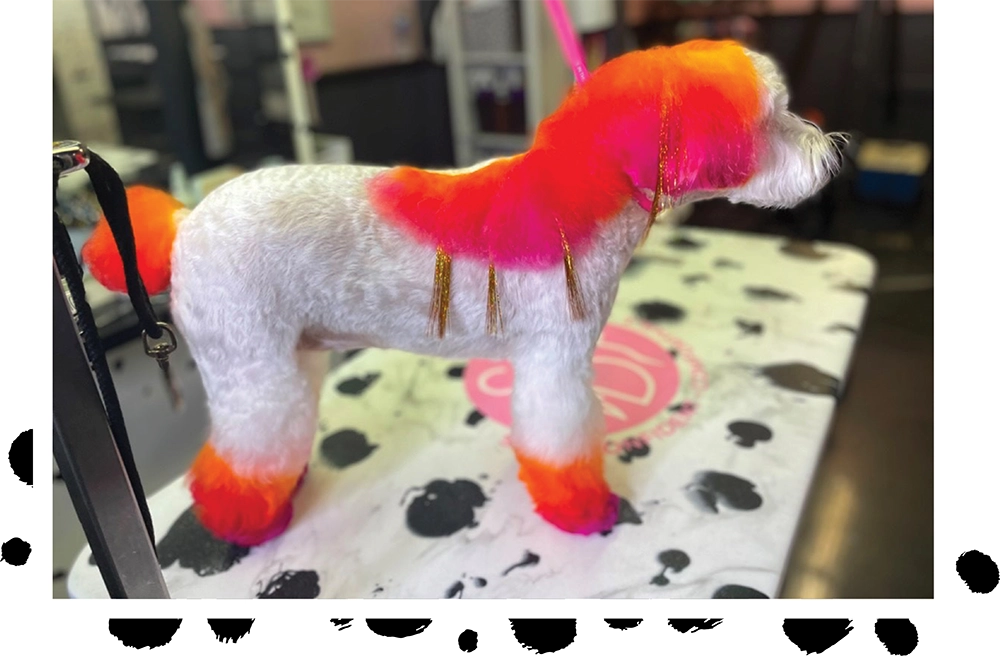
That was one of the inspirations for Plush. In fact, a key aspect of Plush’s approach is that they take the time to sit down and have a meet-and-greet with each of the members.
“This allows their dogs to adjust and relax in our environment while we provide reassurance and discuss the processes at Plush,” Sarah explains. “We prioritize a no-rush atmosphere, fostering strong relationships that develop over time with our regular members during each visit.”
That means there are no time limits placed on services—however long it takes to be groomed comfortably and safely is what it takes.


Plush also practices “Balanced Socialization,” which means throughout the whole process, the dogs will spend time in a calm and balanced environment.
“For me, grooming is about building relationships with dogs,” Sarah notes. “I may have dogs here anywhere from five to eight hours. The importance of having a space where dogs can come and feel the environment and connect with us is something that separates us. We allow breaks in between so the dogs can shake it off, go play, lay down or whatever they choose to do.”
In addition to Sarah, her husband, Ramiel, serves as CEO and a grooming assistant, and Plush also employs a client care coordinator, LaQuita, and an assistant, Drouin’s mom, Cheryl.
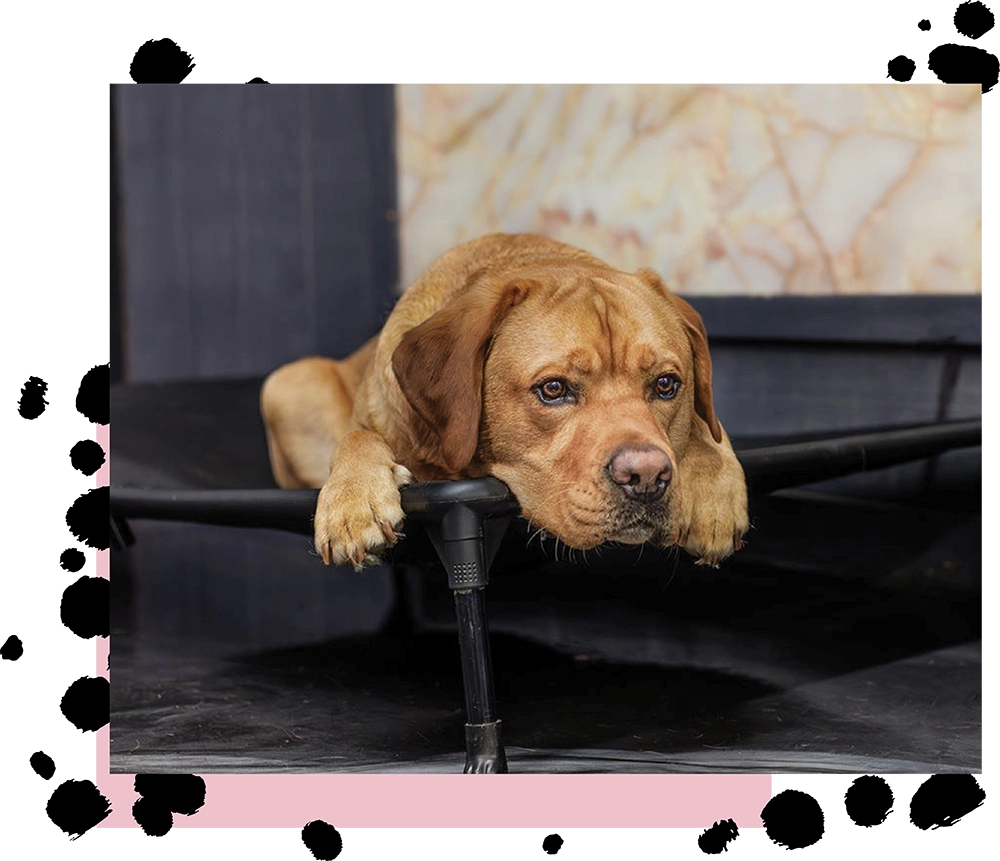
with dogs.”
– Sarah Drouin
“I look to see if they answer the questions in a way that aligns with our ethics, morals and standards,” Sarah explains. “What that application process has taught us is that a lot of people haven’t planned ahead, and we can see who is committed to their dogs’ overall health.”
Although Plush is only five years old, the salon’s history dates back to 1983. Sarah worked for the original owner while she was learning the craft, and when she found the business was up for sale, she immediately jumped at the opportunity.
“I basically took over a building that was already set up for grooming, so the space may not be exactly how I would have set it up,” she shares. “I revamped around what was here.”
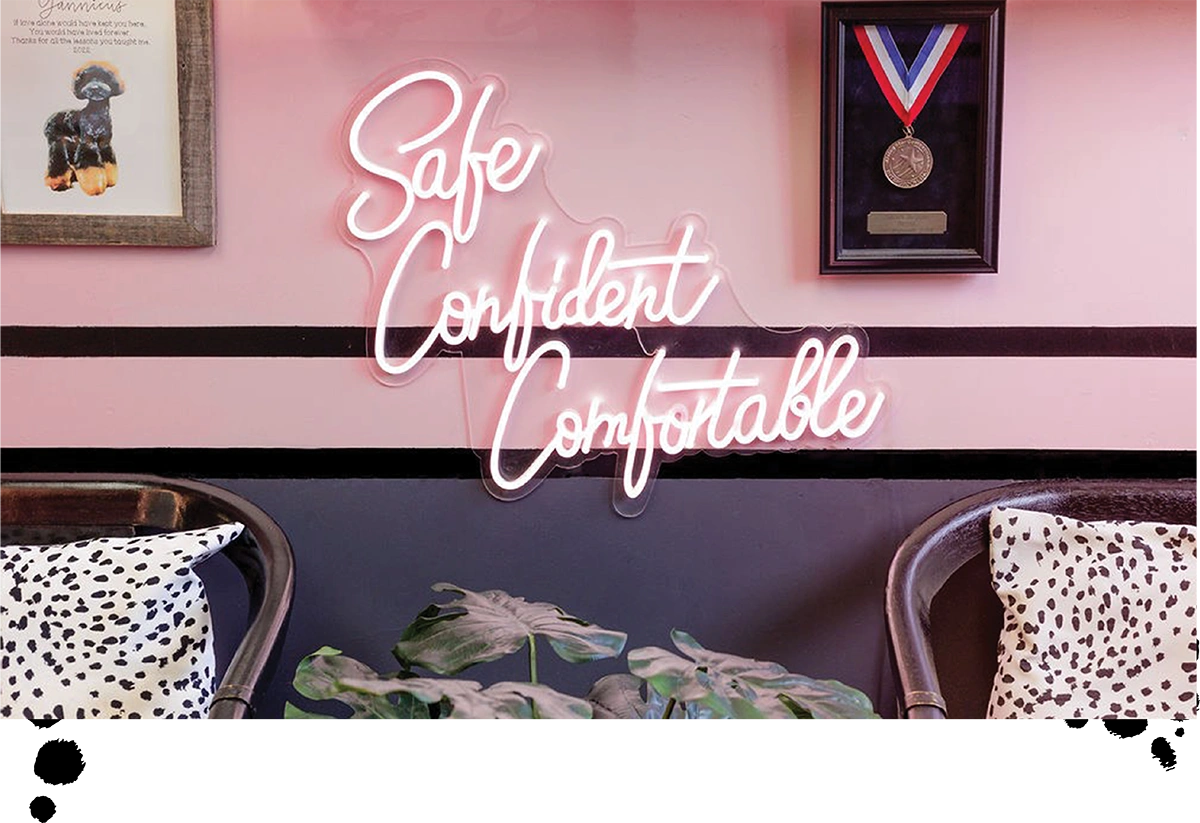
“Everything feels open,” she shares. “While we certainly embrace a lively energy, it is vital that we also foster a calm and relaxed environment for our clients.”
Plush also places a high priority on cleanliness throughout the establishment. This includes meticulous cleaning in UV ovens, as well as stringent methods for maintaining tables, floors, tubs, condos, beds and other areas.
“It is crucial for us to ensure that everything is thoroughly cleaned and well-maintained,” says Sarah. “Additionally, the ambiance of our salon is of utmost importance, specifically in terms of scent. We strive to create a welcoming environment that not only looks clean, but also smells inviting, as this is something our clients truly appreciate.”
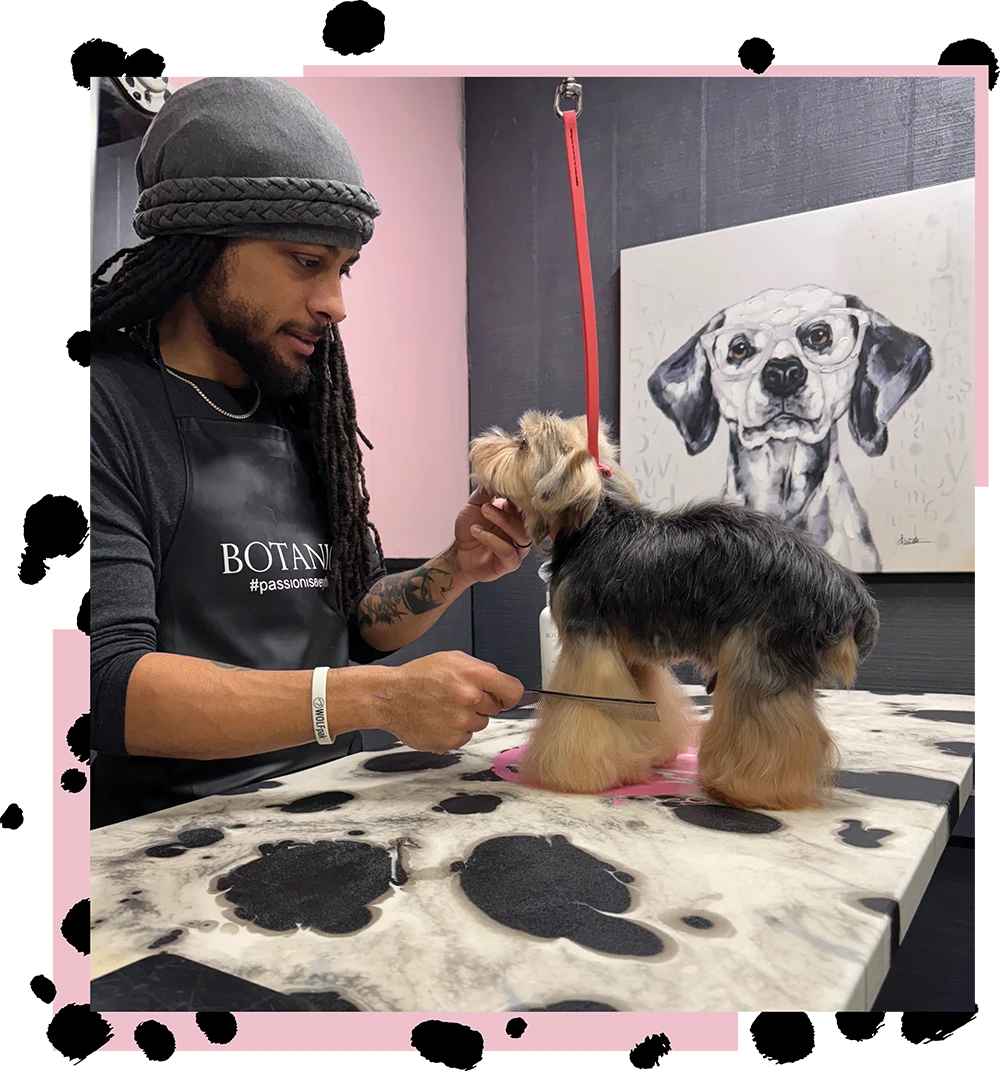
“Dog psychology has always been the center of what I have wanted; you grow and make changes, but it’s definitely my centered thing, because there’s so much more that’s happening other than a physical feeling or luck,” she explains. “We’re touching the brain of the dog, which is so important. We help them learn to be social in an environment that is calm and controlled.”
As much as Sarah is known for doing beautiful haircuts, the core value for her is that the dogs feel good when inside the walls of Plush.
“I want to continue to be great and teach dog psychology, tying it into grooming. Hopefully, our salon can continue to be a good example of setting the bar and raising it,” she concludes.



 he pet industry has been emerging in recent decades to become a major economic presence. Groomers have grown from being somewhat of an underground economy to being a mainstream, high-profile, valued business and service. We welcome this emergence into the cultural and economic mainstream. However, this increasing attention to our industry is bringing to light the need to purge some legacy practices still present in our industry that have long been illegal and problematic.
he pet industry has been emerging in recent decades to become a major economic presence. Groomers have grown from being somewhat of an underground economy to being a mainstream, high-profile, valued business and service. We welcome this emergence into the cultural and economic mainstream. However, this increasing attention to our industry is bringing to light the need to purge some legacy practices still present in our industry that have long been illegal and problematic.
This higher public profile also likely explains why, when I opened my grooming salon a decade ago and called the Illinois state agencies to set up my sales tax and other legalities, the official on the phone said to me, quite earnestly, “You had better report everything correctly—we are on to you all in the grooming industry!” While I was surprised he said that, I assured him that we would follow the law carefully.
Resources for Legal Compliance
I also highly recommend everyone take a business course at a local community college, in person or online. These classes are affordable, not academically difficult, and can even be taken for no college credit. A business class will stand you in good stead all your life in helping you keep your own financial records, do your taxes, work safely and profitably, or grow your own economic security.
Many groomers still work for cash, which is illegal when not reported as income. Many employers pressure groomers to skirt the law with them by mutually agreeing to not treat the groomer as a legal employee, putting both at risk. Other trade industries such as beauticians, plumbers, and electricians have become more regulated and even licensed. This regulation and licensure is surely coming our way and has already been proposed in several states.
Groomers are subject to all the same federal and state labor laws as everyone else. If you are a business owner who has other staff working for you and do not have the current year’s federal and state labor law poster hanging on your wall, you are in violation of the law. These can be purchased for a nominal fee each year.
Employers must abide by laws regarding medical leave, paid time off (PTO), hours worked, minimum wage, overtime rules and mandatory reporting. Many states have requirements unique to that state, such as a requirement for annual sexual harassment training for all staff in a workplace. Your local or state Chambers of Commerce may be able to guide you, or you can call your county government officials. Your county animal control may have regulations applicable to your business as well.
Without a doubt, in a service industry like ours, labor is always the business owner’s highest percentage of expenses…and owners are always trying to find ways to cut costs. But workers’ rights must be respected, because these workers are the ones enabling the owners to make money. A good relationship between owners, managers and workforce will mean more productivity, more loyalty and higher-quality work. A stressed workforce invariably produces lower-quality work and reduces productivity.
All grooming businesses with employees, no matter where they are located, must have Worker’s Compensation insurance. Check requirements in your area. Also, Sole Proprietorships must pay half of their Social Security and Medicare for themselves throughout the year. This requirement cannot be ignored, and it will benefit you years from now. Business licenses are also usually required, but find out if it is by county, city or state in your area.
Groomers must comply with all zoning issues and local ordinances, even if they are working from their home. Find out what zoning and local ordinances apply to you. We must also set up and pay sales tax if we have any retail items such as grooming tools, treats or pet supplies.
There are often environmental requirements in most localities. These could affect trash removal and how you manage cleanliness, waste, sanitation, etc. You also must have appropriate types and numbers of fire extinguishers on premises and know how to use them. Fire extinguishers must be inspected and tagged regularly to ensure they are always working. Regular fire marshal inspections are generally required as well, no matter where your business is set up to operate from.
The American Kennel Club, International Professional Groomers and other pet industry organizations offer voluntary, but valuable, safety certifications for individual groomers and salons. These grooming-industry-based credentials are not legally required, but they do enhance your expertise and are a great thing to brag to your clients about, setting you apart from competitors.
Do not try to avoid paying taxes—it is truly a no-win situation for you. As the gentleman on the phone with the Illinois Commerce Commission told me, they are “on to us,” and they know that our industry has a legacy culture of working for cash under the table. If you are found guilty of not paying taxes, or violating labor laws or other legal requirements, you can be fined and put out of business, as well as held personally liable, which means your home and possessions could be at risk.
Many grooming businesses, however, still are using this model illegally. When businesses illegally pay groomers as independent contractors, it places the responsibility on the groomers to report the income on their personal taxes. Groomers often do not even know their obligations, so they end up as a tax cheat either knowingly or out of ignorance of the law, which we all know is no excuse. Workers new to the country are especially vulnerable.
If we do any remodeling, building or improvements, we must get a building permit as required by law. Building codes can be local, county, state or national. No matter where you groom, you are responsible for following codes that are applicable to where you are doing your grooming.
Carrying business and/or liability insurance may or may not be required, but it certainly is a good idea if want to keep your business. There are myriad of laws that could affect what we do every day, especially since we work with animals. Some states, for example, have bite laws that require them all to be reported, no matter the severity of the bite. A pet getting sick or injured, or worse; or a person getting injured on your premises, could happen at any time.
To learn more about the many miscellaneous laws that can affect you, consult with local Chambers of Commerce or an attorney, or search on your state’s legislative websites using keywords or search terms for laws that might affect you. Better yet, join your state grooming association or form one if your state does not yet have one. Contact the World Alliance of Grooming Associations (WAGA)1 and they will help your state to create a grooming association if it does not have one.
The problem we face is the urge people often have to increase their earnings by cheating the government and the public coffers by doing something illegal or taking advantage of their employees. Instead, be knowledgeable and be proud that you are the kind of person who knows and follows the law with integrity. Laws are a public good, and everyone following them makes life safer and better for all of us.
- World Alliance of Grooming Associations Inc. https://waga.wildapricot.org/


 o you ever wonder how groomers who have been happily at the table for decades build those successful, long-term careers? Is it mastering breed profiles? Is it keeping up with the latest trends and techniques? Is it having mad business skills? Perhaps it is all these things and more. Read on for eight steps to get yourself to grooming success!
o you ever wonder how groomers who have been happily at the table for decades build those successful, long-term careers? Is it mastering breed profiles? Is it keeping up with the latest trends and techniques? Is it having mad business skills? Perhaps it is all these things and more. Read on for eight steps to get yourself to grooming success!
1. Never Stop Learning
Acquiring new information and skills helps keep our work fresh and interesting. Things are constantly evolving; there are new tools to try and new products that make our job easier and give better results. And while we are an unregulated industry, you might consider gaining a voluntary certification to polish your skills and gain some credentials. Groomers who are in this career for the long haul keep themselves relevant by committing to life-long learning.

In our line of work, we can express our creative side while still being professional by communicating clearly with our customers and co-workers, fulfilling our promises, and taking care of business in an organized, consistent manner. This means good record-keeping, running things smoothly, and keeping a sanitary and attractive workspace.



If you have trouble with this, consider hiring an accountant or bookkeeper and someone to help you set up investments so that you can retire comfortably when it is time to put the scissors down.


Last year, I was contacted by a groomer who wanted to learn more about a specific skill that I have some expertise in. I invited her to hang out with me on a workday and ask questions while she watched me groom. I enjoyed spending time with another groomer for a few hours, and I think she got some of her questions answered.

8. Take Care of Yourself
Groomers in this career for the long haul know that it takes more than clipper and scissor skills to keep them working for decades in this demanding but fulfilling career. What areas of your job do you need to focus more energy on to keep you happily—and successfully—grooming for years to come?

 s groomers, many of us work solo, especially those who are mobile and house-call. And while we are well-educated and experienced in handling the uncooperative or aggressive dog, we might not always take into consideration another danger we face…people.
s groomers, many of us work solo, especially those who are mobile and house-call. And while we are well-educated and experienced in handling the uncooperative or aggressive dog, we might not always take into consideration another danger we face…people.
We all have a horror story of sorts of an uncomfortable encounter with a client—some of us more than one. Here is one of mine: I was grooming a new Golden Retriever while the dog’s owners hosted a party. The male owner came into my grooming van, holding a beer, and obviously a little drunk. I then realized I didn’t know anyone at that party and wondered if anyone would even help if I called for assistance. Fortunately, he didn’t care for bumping into the sharp end of my scissors, which were pointed in his direction, and he left without incident. But that could have been a different story, and I instituted many changes from that day forward.
While I wish I could say that this behavior is uncommon, it’s been the topic of many of our industry podcasts. So, how can we reduce or eliminate these human horror stories?


- Listen to your gut. Hunch, instinct, deeper knowing…whatever you call it, these are just some of the many names for feelings or the ability to understand something is off without immediate conscious reasoning. Pay attention to those feelings. Your subconscious has picked up on behavioral cues that indicate danger.
- Secure the location. Close and lock doors. Door and window screens are not a deterrent, as someone can quickly push through. Think about installing a door-buzzer entry system, which you can get for under $200 on Amazon. Buzzer systems also have the added benefit of owners not distracting their dogs by entering your place of business early. If you’re mobile, lock all entry doors. And if you’re house-call, ensure there is always a clear line of sight to any exit.
- Carry a weapon. Know the laws in your state before deciding on any weapon. Before I retired in CT, I could get a Conceal Carry permit for a gun but couldn’t legally own pepper spray. Weapons are dangerous and can cause harm or death. Proper and continual training is a must.
- Do an internet search for sex offenders. Google sex offender/state/county. It will pull up a map in which you put in an address and set the radius, and it will list all registered sex offenders in that radius. Don’t assume you will be safe because of women in the household, sometimes they act as an accomplice.
- Install a panic button that links to the police department. A security company is your best option for installs, especially for remote use by mobile and house-call groomers. However, alarm companies such as Ring may have options as well. Call 911 when any client acts in a threatening manner and inform the 911 dispatcher that you are in physical danger.

You do not have to groom any pet just because someone has made an appointment and shown up at your business, or greets you at the door for mobile or house-call services.


- Say no. You do not have to groom any pet just because someone has made an appointment and shown up at your business, or greets you at the door for mobile or house-call services. On more than one occasion, I made up some excuse to leave after arriving at the client’s home simply because I didn’t feel comfortable.
- Take a self-defense class. Your local police department may have a listing of self-defense classes and weapons training programs. Often these are available through a community center or YMCA.
- Be aware of psychological abuse. This behavior includes threatening, belittling, blaming and making fun of, and it can come from a client, employer or another employee. Your best option as an employee is to talk to your employer if it regards another employee or client and keep documentation. If it’s your boss, the same advice holds: speak to them about it and document it, and maybe be prepared to find alternate employment. If it’s a client and you work alone, it’s best to tell them to find a new groomer.
- Protect your employees. If you’re a business owner, you are responsible for providing safe working environments for your employees. Discussing those responsibilities with a local business attorney is a good place to start.
Resources:
- USCCA’s Concealed Carry Reciprocity Map & Gun Laws by State. https://www.usconcealedcarry.com/resources/ccw_reciprocity_map/
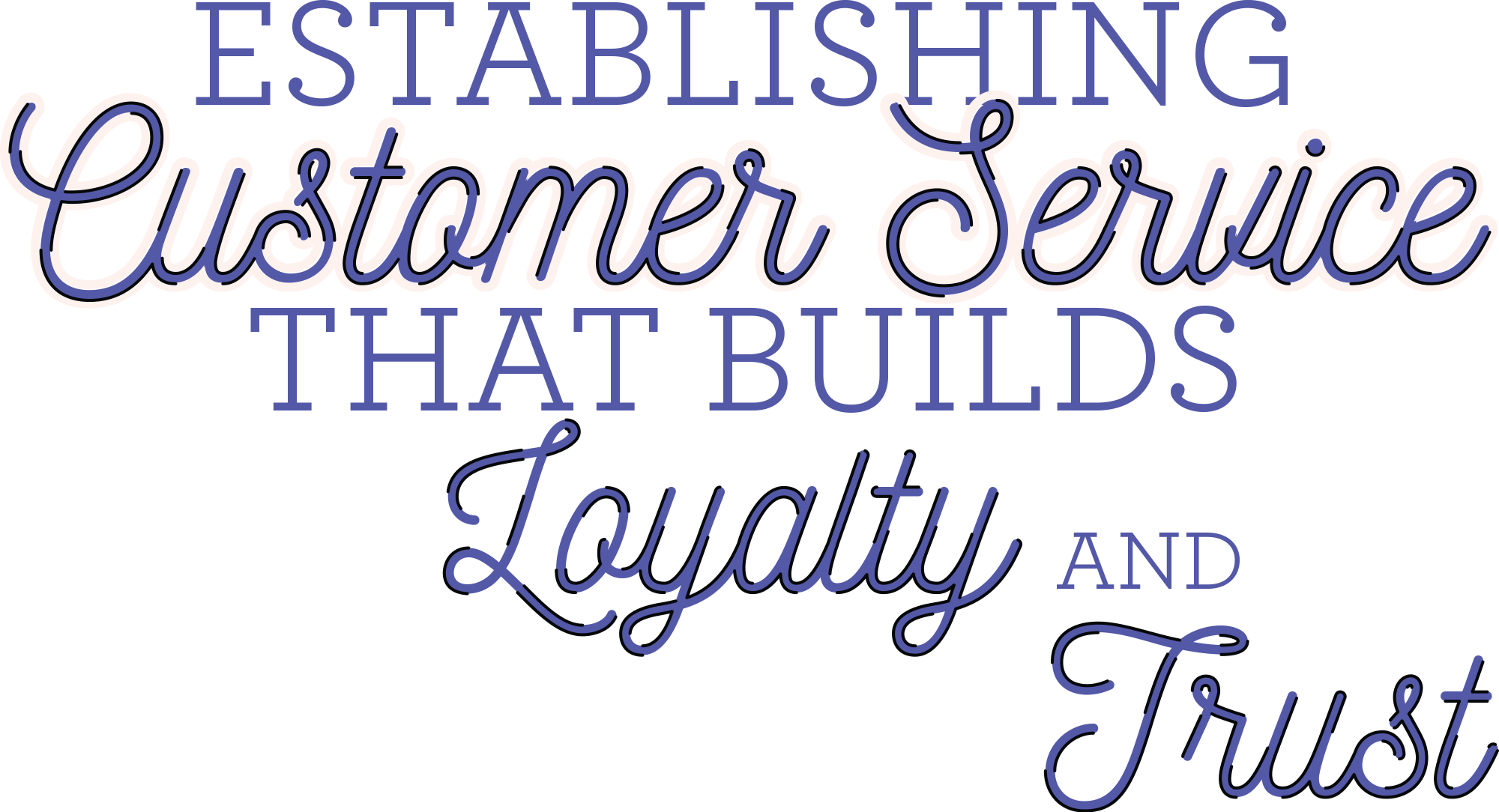
by Kim Kier
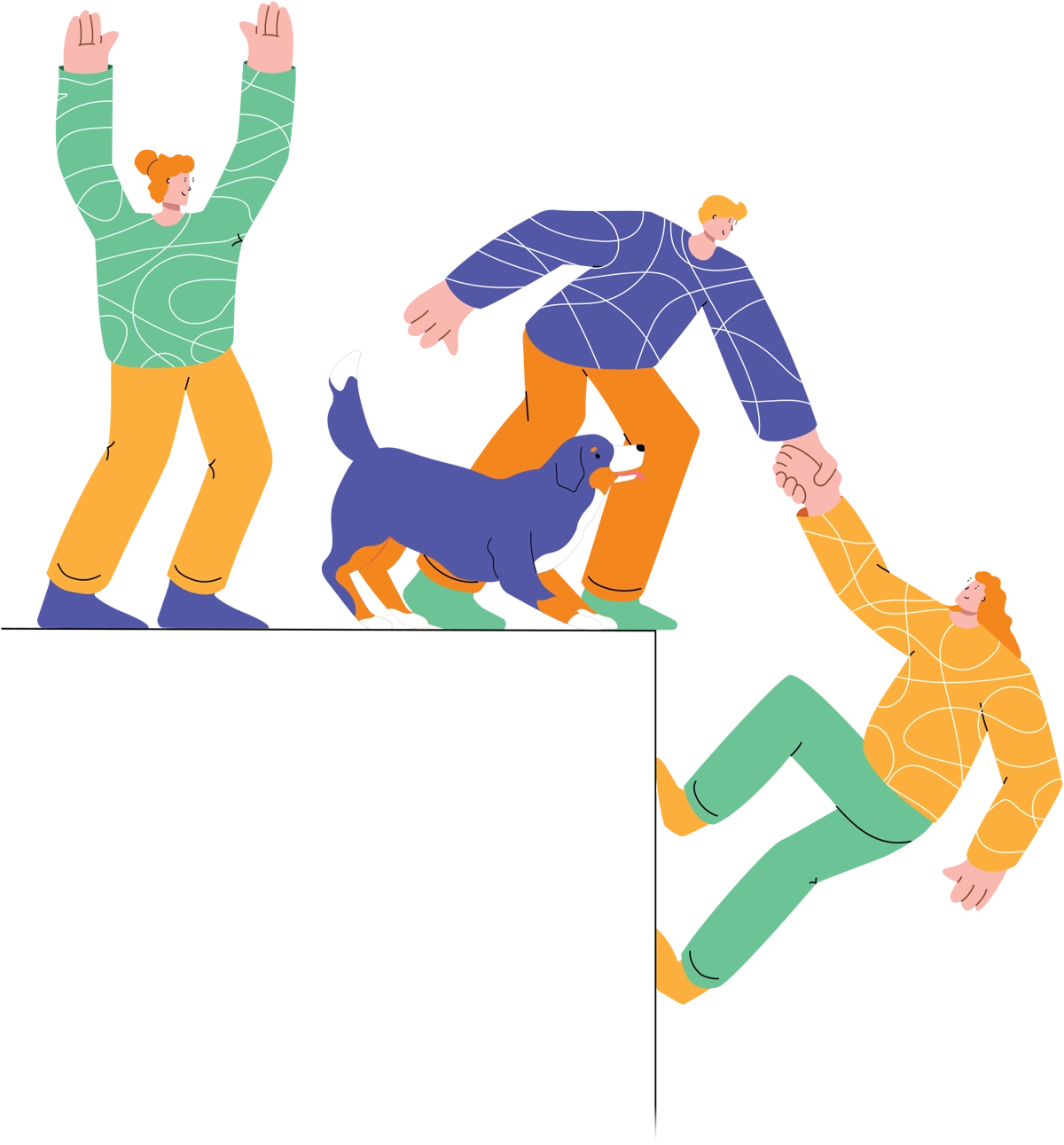
 he heartbeat of any business is the customer, and how we interact with them can make or break our success. With thousands of books and just as many business coaches and gurus, it’s no wonder we sometimes feel overwhelmed. My goal with this article is to simplify customer service and gear it specifically toward our grooming industry. I’ll share a few questions I ask myself regularly to reflect on how I serve my clients, and also the seven key factors that have guided me over the years.
he heartbeat of any business is the customer, and how we interact with them can make or break our success. With thousands of books and just as many business coaches and gurus, it’s no wonder we sometimes feel overwhelmed. My goal with this article is to simplify customer service and gear it specifically toward our grooming industry. I’ll share a few questions I ask myself regularly to reflect on how I serve my clients, and also the seven key factors that have guided me over the years.
In my salon, the dog is the true client—the person just pays. I know this sounds a bit “haute” or lofty, but this holds true in nearly every case: When the dog is happy, the owner is happy!
The first question I often ask myself is:
“How can I make the pets in my salon comfortable, calm, and excited to run in the door?”
My answer is simple: I take the time to build a relationship with every dog that comes into the salon. That relationship is built on trust, compassion and safety. When the dog feels safe, they trust me. And when they trust me, they feel the love and compassion I have for them.
Building trust and rapport with each pet is key. When dogs feel calm and at ease with you, it makes the entire grooming process smoother for both the pet and the owner.
The second question I ask myself is:
“Am I keeping up my end of the unspoken agreement between me and my clients?”
I expect my clients to be on time—am I punctual? Do I open on time? Do I complete the groom by the time promised? I expect them to be polite and honest—am I always polite and honest in return? We cannot expect things from others that we are not willing to give ourselves. Lead by example.
Here are my seven proven customer service tips to apply to your grooming business:
- Active Listening: Listen to truly understand, not just to respond. Take notes if necessary, but make sure to address all of your clients’ requests and concerns during check-in. Active listening shows that you care about both the pet and the owner’s needs.
- Personalized Attention: Smile and maintain a positive attitude. Greet each client (both dog and owner) by name. Engage in small talk, ask about their day and make them feel valued. That extra minute of personalized attention helps set a positive tone for the entire grooming experience.
- Compassion: Let your kindness shine through. It’s one of your most powerful tools to show clients that you care and that their pets are in safe hands. Compassion builds trust, and clients can feel when their pets are treated with love and care.
- Trust: Trust between you and your clients is essential for many reasons. They need to trust you to share important details about their pet’s health, behavior and personality. In return, they trust that you will keep their pet safe, handle them with compassion, and perform the grooming services with skill and professionalism. When you establish trust, you lay the foundation for a loyal, long-term relationship.
- Professionalism: Professionalism is key in attitude, appearance and conduct. Always put your best self forward, whether you’re interacting with clients or grooming a dog. Share your knowledge, skills and talents with confidence to ensure the best possible care for every pet.
- Organization: Being organized helps you work efficiently and shows clients that you’re committed to your salon and the care you provide. Stay on top of your schedule, keep grooming tools in order and manage your appointments with precision. A well-organized salon fosters trust and reliability.
- Time Management: Keep your day flowing smoothly without feeling rushed or overwhelmed. Understanding how long each groom takes and adjusting accordingly prevents mistakes. When you’re not rushed, you think more clearly and deliver better results. This demonstrates to your clients that you respect their time and keep your promises, which in turn helps keep them loyal.
When you invest time in building relationships with both pets and their owners, you not only enhance the grooming experience, but also foster loyalty and trust—two key ingredients for long-term business success. Your clients will feel valued and confident that their pets are in the best hands. And when the dogs are happy, the owners are, too!
Kim Kier is the owner/groomer of Little Barks Grooming & Boutique, an award-winning luxury salon in Columbia, South Carolina. She is also a Master Pet Aesthetician, Professional Grooming Credential (World Pet Association), Master Groomer Behavior Specialist, Fear Free Professional, Low Stress Handling Level Silver Certified, and Certified Puppy Consultant.


 s one of the few businesses in my area specializing in grooming and training dogs with behavioral challenges, I encounter fascinating and complex cases. I’m often contacted to evaluate dogs that attempt to bite the groomer or dogs with an aversion to touch—both at the grooming salon and sometimes even at home.
s one of the few businesses in my area specializing in grooming and training dogs with behavioral challenges, I encounter fascinating and complex cases. I’m often contacted to evaluate dogs that attempt to bite the groomer or dogs with an aversion to touch—both at the grooming salon and sometimes even at home.
One of the most concerning scenarios involves dogs that start biting seemingly out of nowhere. This behavior can happen with dogs of any age. A dog may have visited the same groomer for months or even years without issue, then suddenly tries to bite. Understandably, owners are confused and upset when this happens. How could it happen, and what can they do?
During a behavioral grooming session, I focus completely on the dog’s behavior. I often collect data, such as how many stress signals the dog displays throughout the session. This information helps me measure the dog’s progress and understand their communication skills. Every dog I’ve worked with communicates before attempting to bite, even if the communication is very subtle. While it might seem like a dog has attempted to bite without warning, there is almost always a pattern to discover.
I often collect data, such as how many stress signals the dog displays throughout the session. This information helps me measure the dog’s progress and understand their communication skills. Every dog I’ve worked with communicates before attempting to bite, even if the communication is very subtle.
Canine communication is a complex language. Dogs communicate through tail movements, vocalizations, their eyes, head positions, ear positions, and body tension or relaxation. Understanding these cues strengthens trust and reduces stress during grooming, creating a better experience for both dog and groomer.
Dogs also exhibit different behaviors depending on their environment, so reading their body language in context is essential. When a dog is restrained, such as in a tub or on a grooming table, stress signals may change. If these cues are ignored and the grooming continues, the dog may alter its communication. Some dogs will try to escape or avoid the stressful part of the process by lifting their paws, climbing up the grooming arm or pulling away. Others will remain still but carry noticeable tension in their bodies, which you can feel when picking up a paw or placing your hands on them.
How a dog responds to stress—and what they do when they’re unable to escape from the stress—depends on several factors, including upbringing, genetics and past grooming experiences. Stressed dogs that remain silently still often pose the greatest risk of a sudden bite.
When a dog’s communication is ignored, they may stop offering clear signals. The warnings become more subtle and harder to detect, even for attentive groomers. Eventually, the dog may bypass obvious warnings altogether and go straight to biting. So what can groomers do to prevent dogs from reaching the level of reduced warnings?
Another helpful technique is to establish a predictable grooming pattern. For example, if a dog resists handling on one paw, touch the shoulder before reaching for that paw each time. This creates a consistent cue, giving you an opportunity to gauge the dog’s response.
If the dog shows stress, pause for a moment. Allow the dog to reset with a shake-off or to loosen their body language. Sometimes praise or briefly unclipping and re-clipping the dog from the restraint can help. Try again, and you’ll often find the dog is more relaxed after acknowledging the warning.
Taking your hands off briefly when a dog shows stress can also make a significant difference. Even a split second helps the dog realize that their body language can influence the outcome, which may reduce stress. The goal is to prevent a dog with mild aversion to grooming from developing serious behavioral problems over time.
Knowing when to refer a client to a trainer specializing in behavioral grooming and cooperative care is also crucial. Helping a dog overcome mild grooming anxiety is part of a groomer’s role, but extensive training during a grooming visit is both time-consuming and potentially dangerous.
Observation goes a long way in the grooming salon. Understanding body language is invaluable for anyone working with animals, as it helps prevent dogs from developing behavioral problems and helps to keep their handlers safe.



 s professional cat groomers, we’ve all heard it before: “But I thought cats groomed themselves?” While it’s true that cats are fastidious lickers, many still develop coat and hygiene issues that require professional intervention. From kittens to super-seniors, each stage of a cat’s life brings different grooming needs and challenges. Understanding these changes is key to keeping cats comfortable and healthy throughout their lives.
s professional cat groomers, we’ve all heard it before: “But I thought cats groomed themselves?” While it’s true that cats are fastidious lickers, many still develop coat and hygiene issues that require professional intervention. From kittens to super-seniors, each stage of a cat’s life brings different grooming needs and challenges. Understanding these changes is key to keeping cats comfortable and healthy throughout their lives.Debunking the Myth: Cats and Self-Grooming
Shedding is another concern. Beyond just being an annoyance to owners, excessive shedding contributes to hairballs, which can sometimes cause dangerous blockages. Other common grooming concerns include overgrown nails (leading to ingrown claws or breakage), flea infestations, dandruff, and even litter box debris clinging to the fur. So, while cats may try to keep themselves clean, professional groomers play an essential role in their overall care—especially as they age.

(13+ Years Old):
The Golden Years of Grooming
Matted fur is another frequent concern, even in short-haired seniors. Because cat skin and coat changes with age and they tend to groom themselves less due to arthritis or mobility issues, their coats can quickly become clumped and matted. However, shaving a fragile senior can be risky; thin skin is more prone to injury, and extensive mat removal can cause unnecessary stress. If shaving is necessary, it must be done with extreme care.
Preventative grooming is the best strategy for senior cats. Regular bathing, blow-drying, and combing can help manage shedding and prevent painful mats from forming. When introduced gradually, many senior cats can tolerate and even enjoy regular professional grooming, which makes a huge difference in their comfort and overall health.

Increased Grooming Needs
Health conditions such as diabetes, thyroid disorders, kidney disease or heart problems also become more common, all of which can affect coat and body condition. Professional groomers should be aware of these changes and alert owners if they have not had the changes checked by their veterinarian. Additionally, the grooming routine may need adjusted to accommodate any health conditions.
Routine grooming can help keep seniors comfortable. For long-haired breeds, a trim or sanitary cut may prevent hygiene issues around the rear, while some may need full haircuts like a Lion Cut (whether removing or preventing mats) or a Comb Cut (can only be done with no matting). The key is to establish a grooming schedule before serious problems arise—waiting until matting, skin irritation or nail issues appear only increases stress for the cat.

Low Maintenance or Preventative Care?
For adults with high-maintenance coats, regular bathing and professional grooming prevent future matting and excessive shedding. Persians, Maine Coons and other long-haired breeds benefit from regular appointments to keep their coats in good shape.
At this stage, owners often seek grooming services due to excessive shedding, skin issues or coat contamination (e.g., a cat getting into something sticky or dirty). Adult cats may also require flea treatment baths, medicated shampoos or sanitary trims to prevent fecal matter from clinging to their fur. The best approach to grooming adults is establishing a consistent schedule, which prevents severe matting or coat neglect that could make grooming more difficult in their later years.

The Surprise Matting Phase
This is the age range where many owners first bring in their cats due to unexpected matting. Breeds like Persians, Ragdolls and Siberians are especially prone to developing tight tangles during this period. Even short-haired cats with dense undercoats can experience increased shedding and clumping.
Professional grooming is crucial at this stage, as gentle de-matting and de-shedding treatments and routine trims can prevent long-term coat issues. Educating owners about regular brushing and scheduling follow-up grooming sessions can ensure their cat’s coat remains manageable into adulthood. Remember, matting is not a one-time thing—if the cat has mats at this age, they will need ongoing help with their coat and grooming needs.

The Perfect Time for Introductions
Bathing kittens is relatively simple when done correctly, using warm water, gentle handling and hypoallergenic shampoo. A soft towel and a low-noise blow-dryer can help keep them comfortable during drying. Nail trims should be introduced regularly, as kitten nails grow quickly and can cause scratches if left too long.
The key to grooming kittens is making it a positive experience. Gentle handling, rewards and short sessions can set them up for a lifetime of stress-free grooming.
Regardless of age, every cat benefits from regular grooming. A well-maintained coat reduces health risks, prevents painful matting and keeps cats comfortable. The key to success is early introduction and consistency—starting young and maintaining a regular schedule helps cats tolerate grooming well into their senior years.
For professional groomers, understanding how grooming needs change over time allows us to provide the best possible care for our feline clients. Whether working with a wiggly kitten, a stubborn adult or a fragile super-senior, each stage requires a tailored approach. Educating owners on proper home maintenance and the importance of preventative grooming ensures happier, healthier cats and less stress for everyone involved.

by Blake Hernandez
 hen it comes to grooming pets, we can stress over a hundred things—cleanliness, client satisfaction, the perfect finish—but the top concern of every single groom should be safety. And not just safety for the client’s trust in you, but also for the safety of your body and the animals in your care. Here are 10 of my biggest safety secrets for the dogs on your table:
hen it comes to grooming pets, we can stress over a hundred things—cleanliness, client satisfaction, the perfect finish—but the top concern of every single groom should be safety. And not just safety for the client’s trust in you, but also for the safety of your body and the animals in your care. Here are 10 of my biggest safety secrets for the dogs on your table: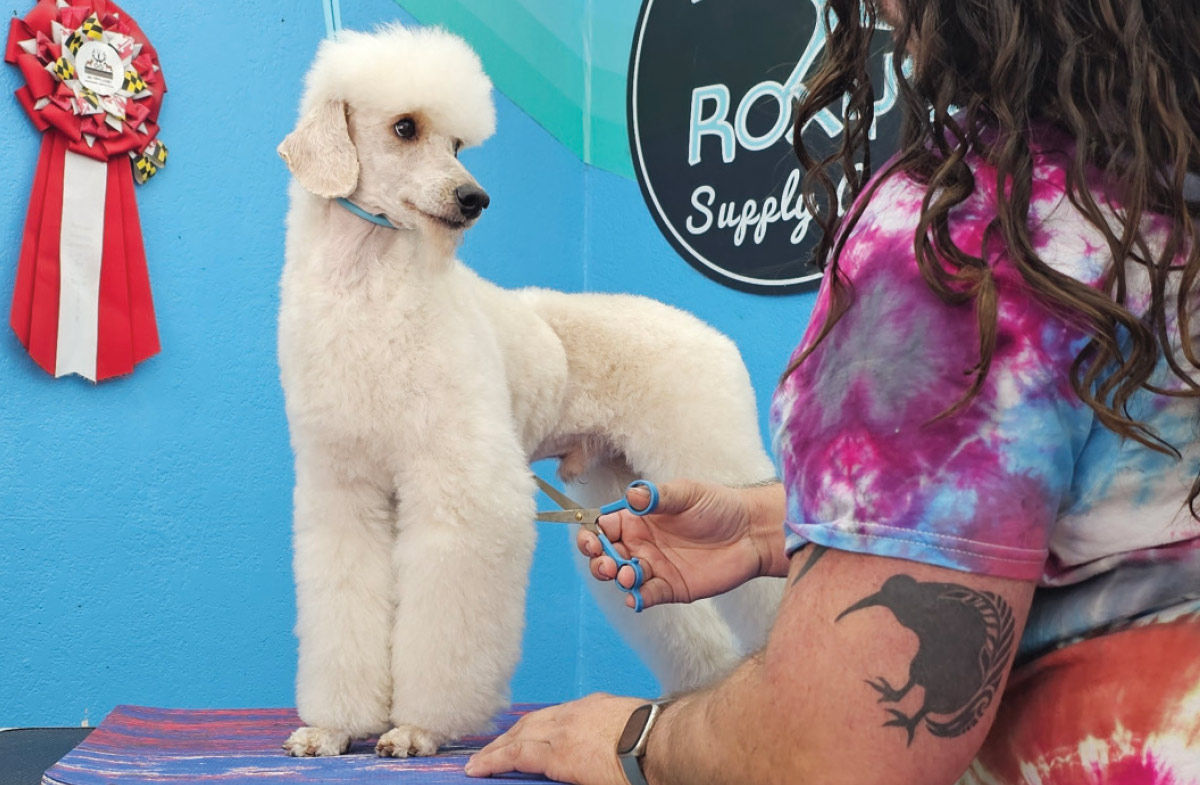
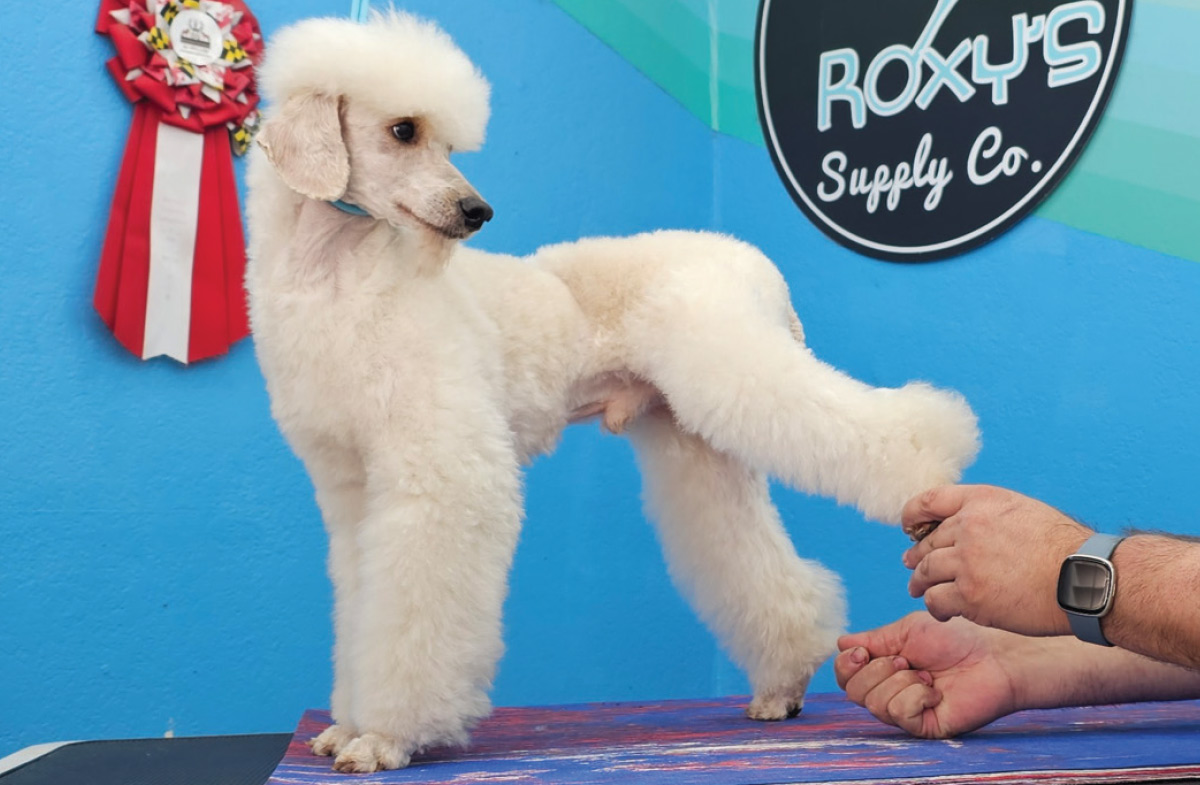
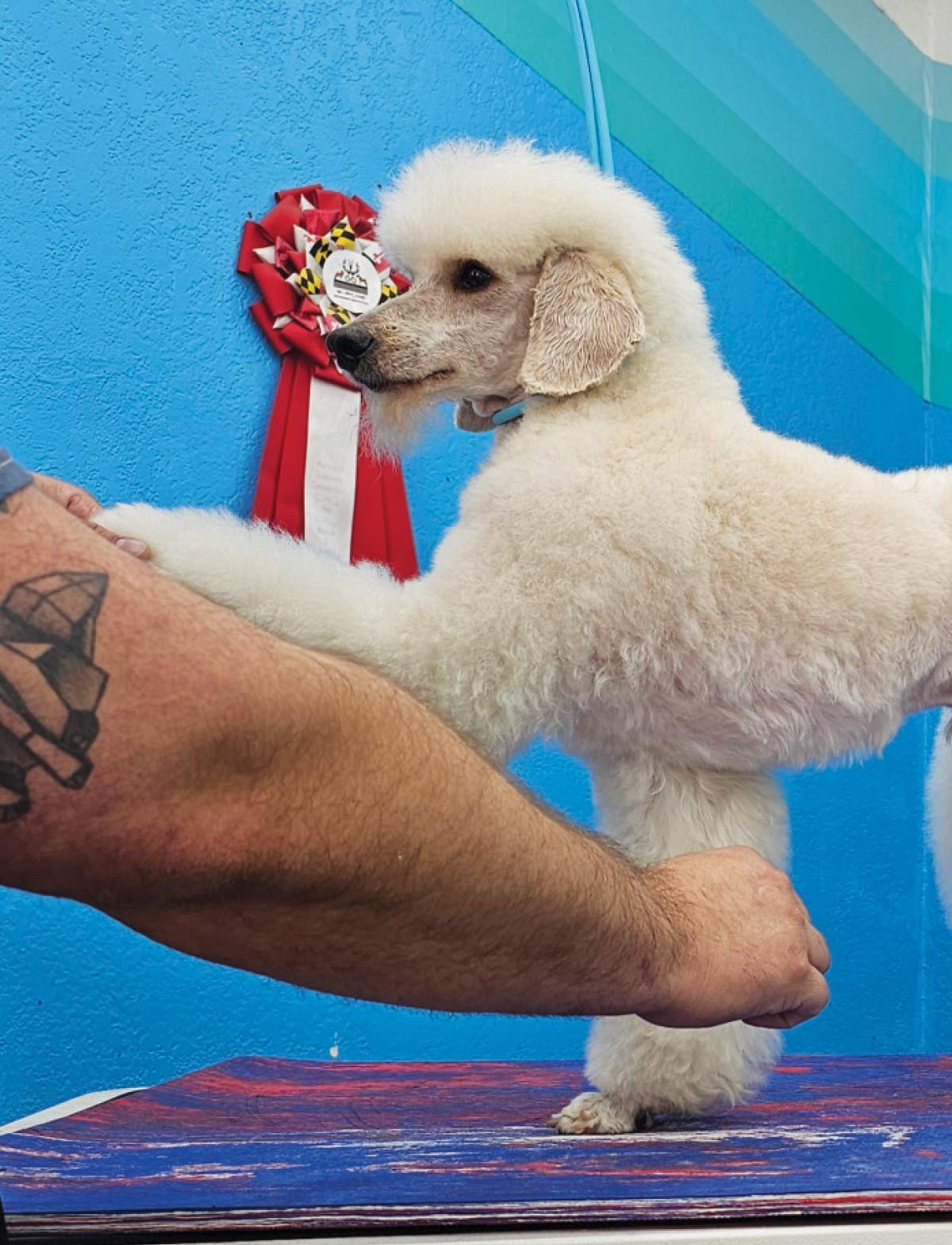
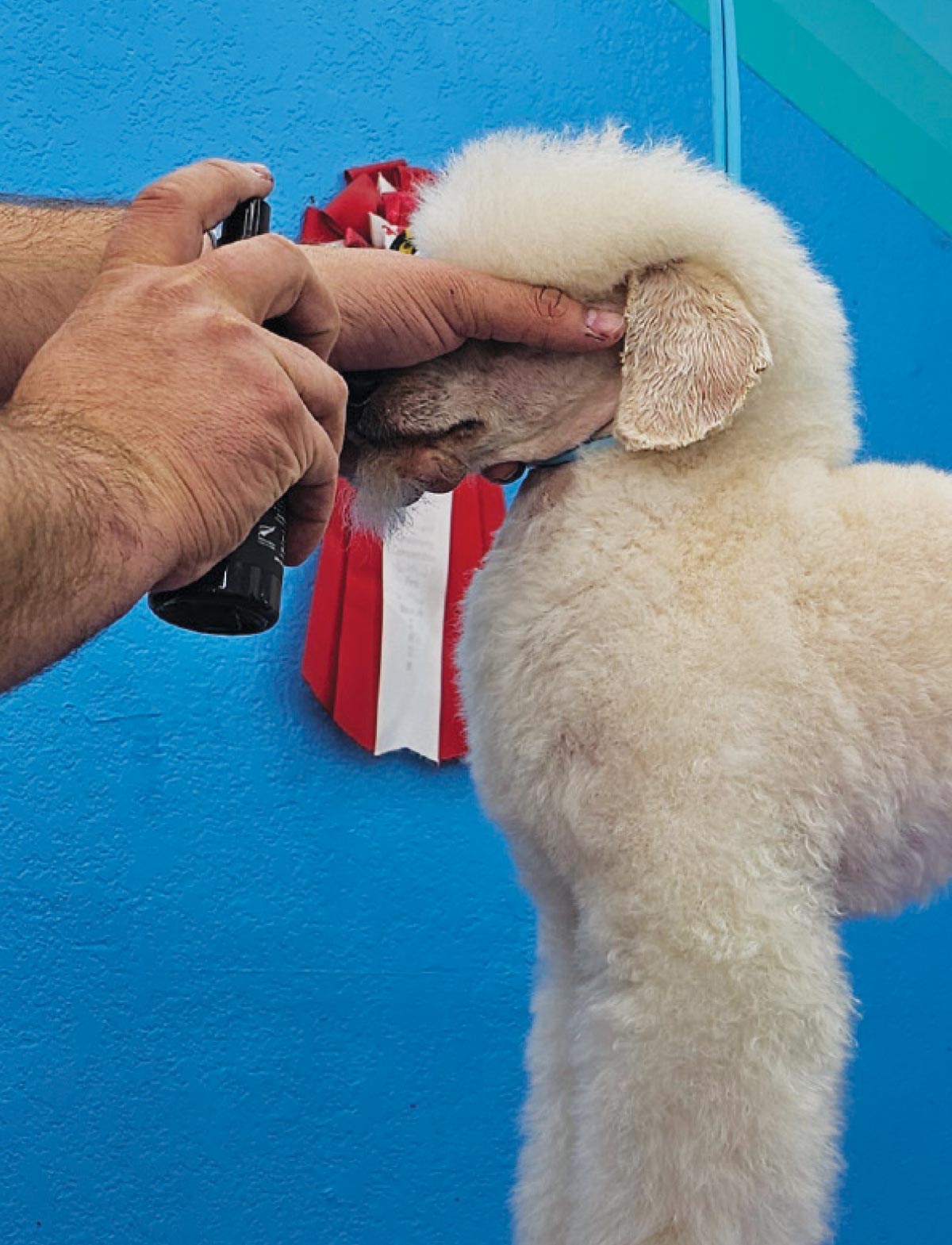
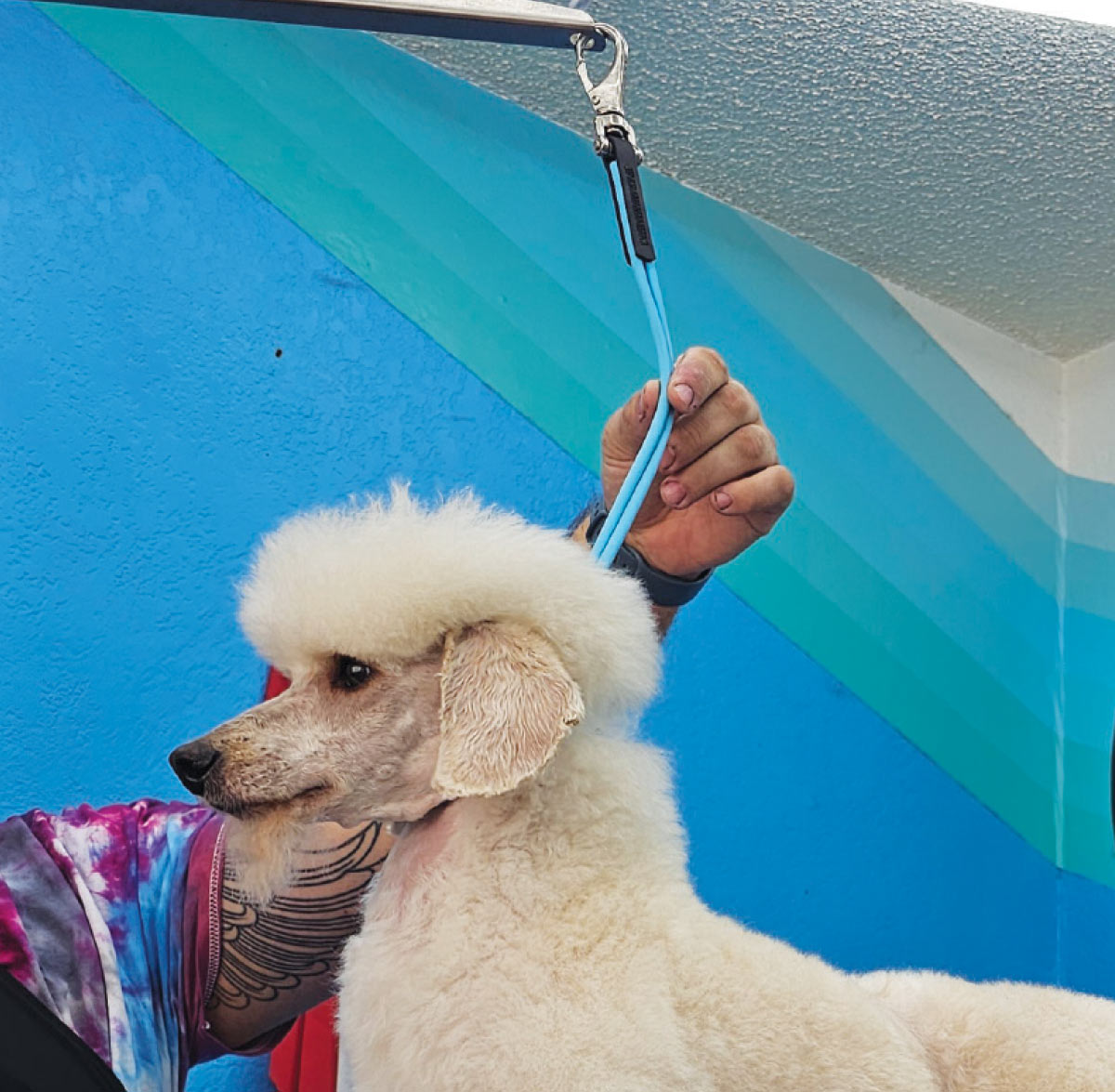
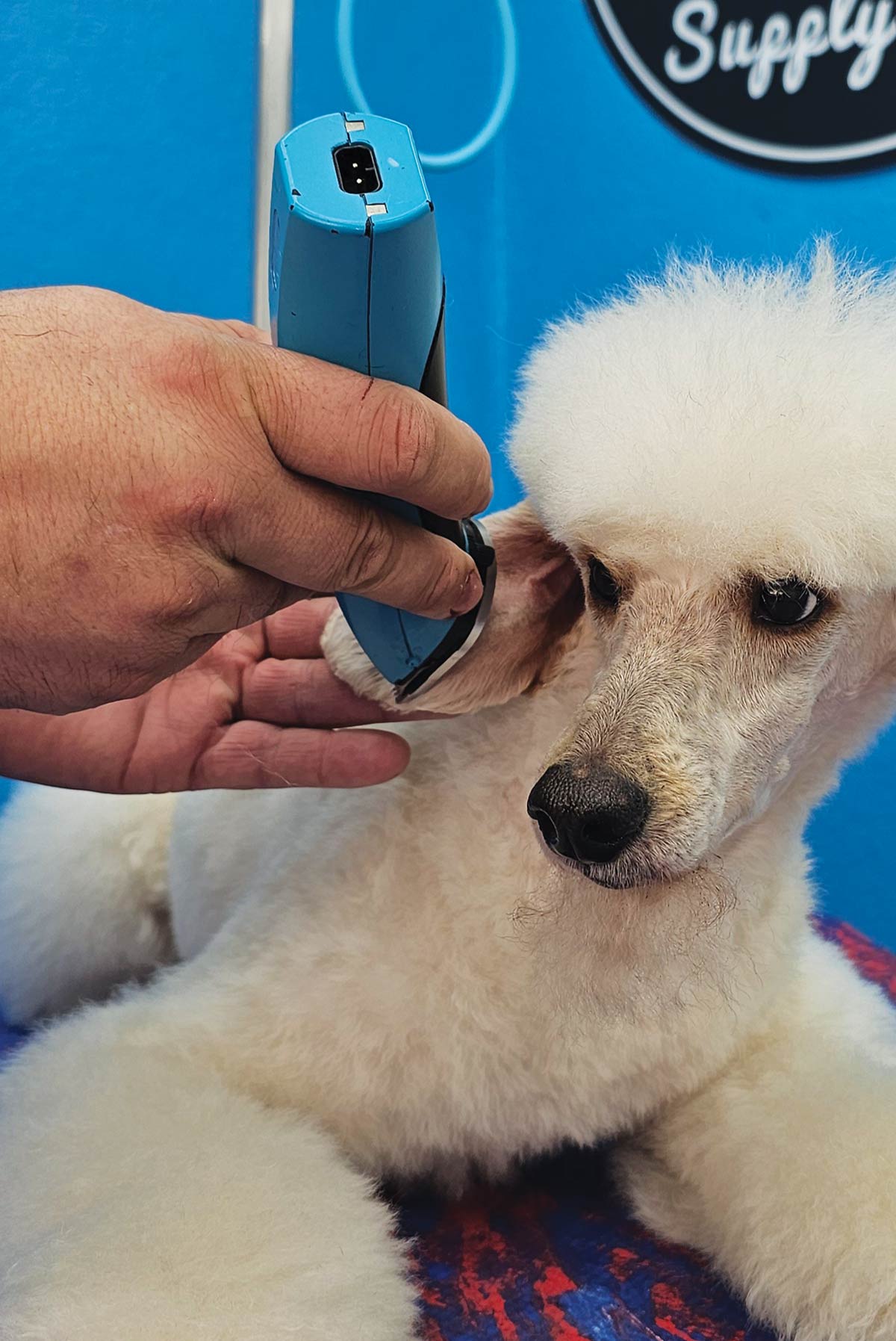
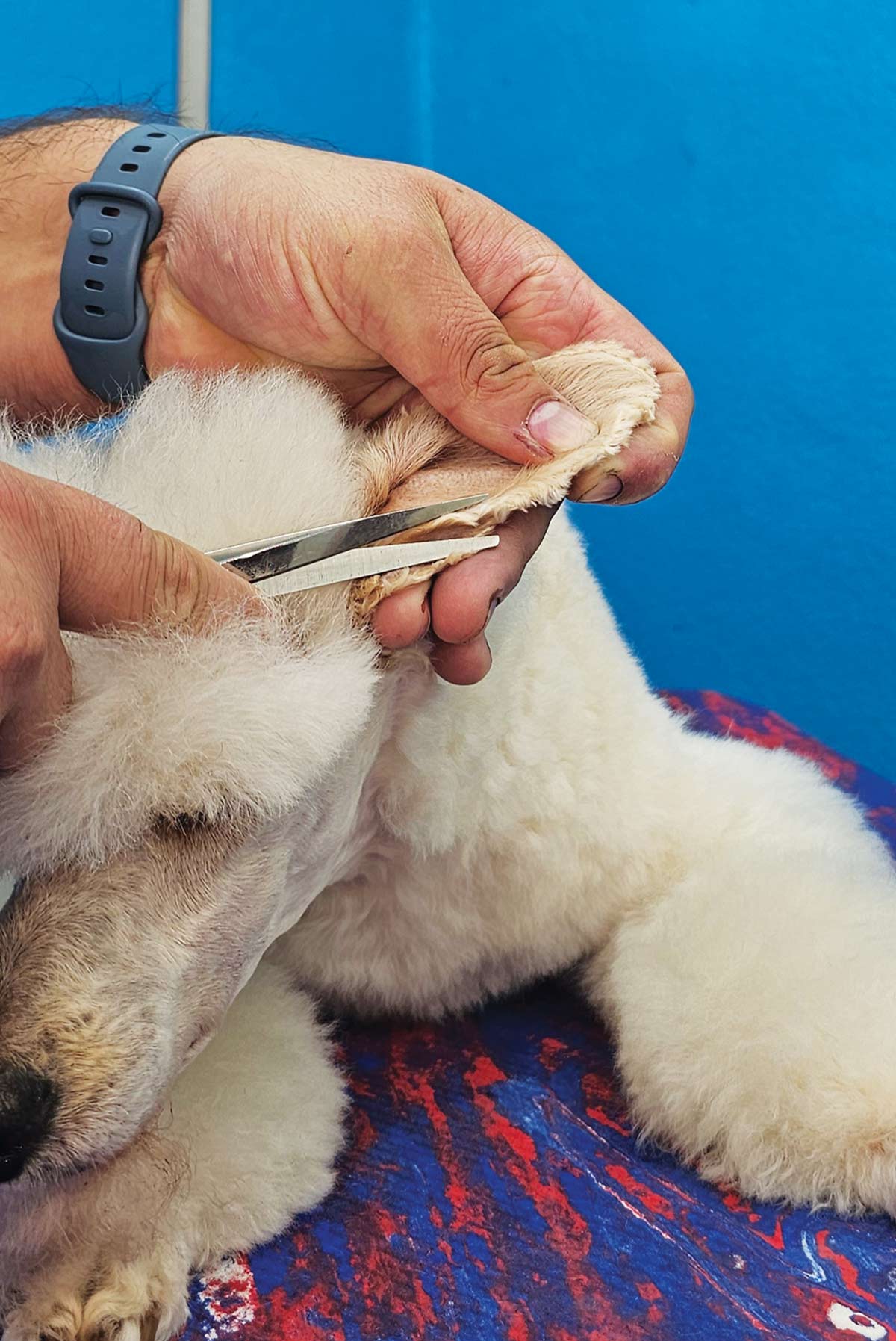
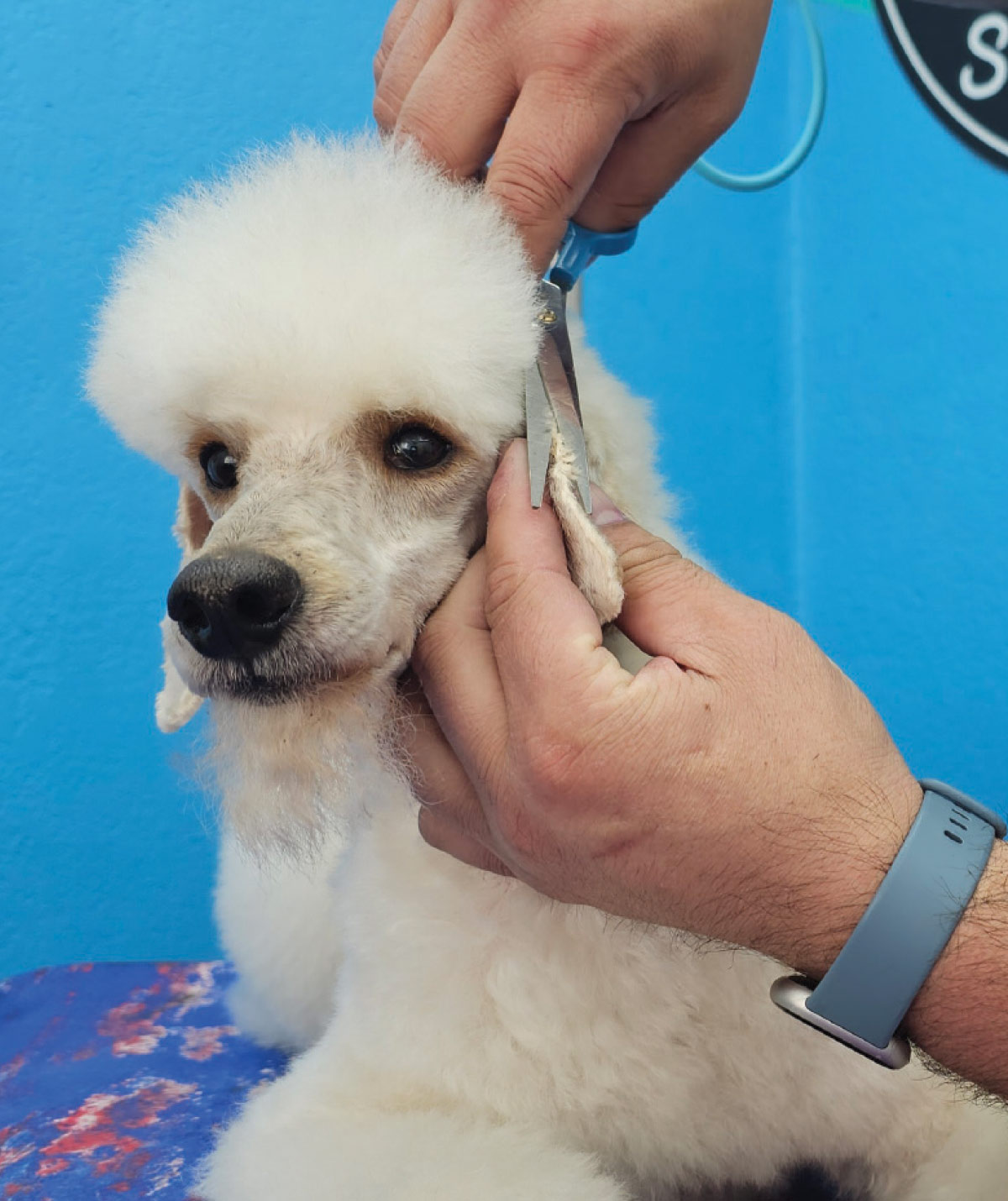
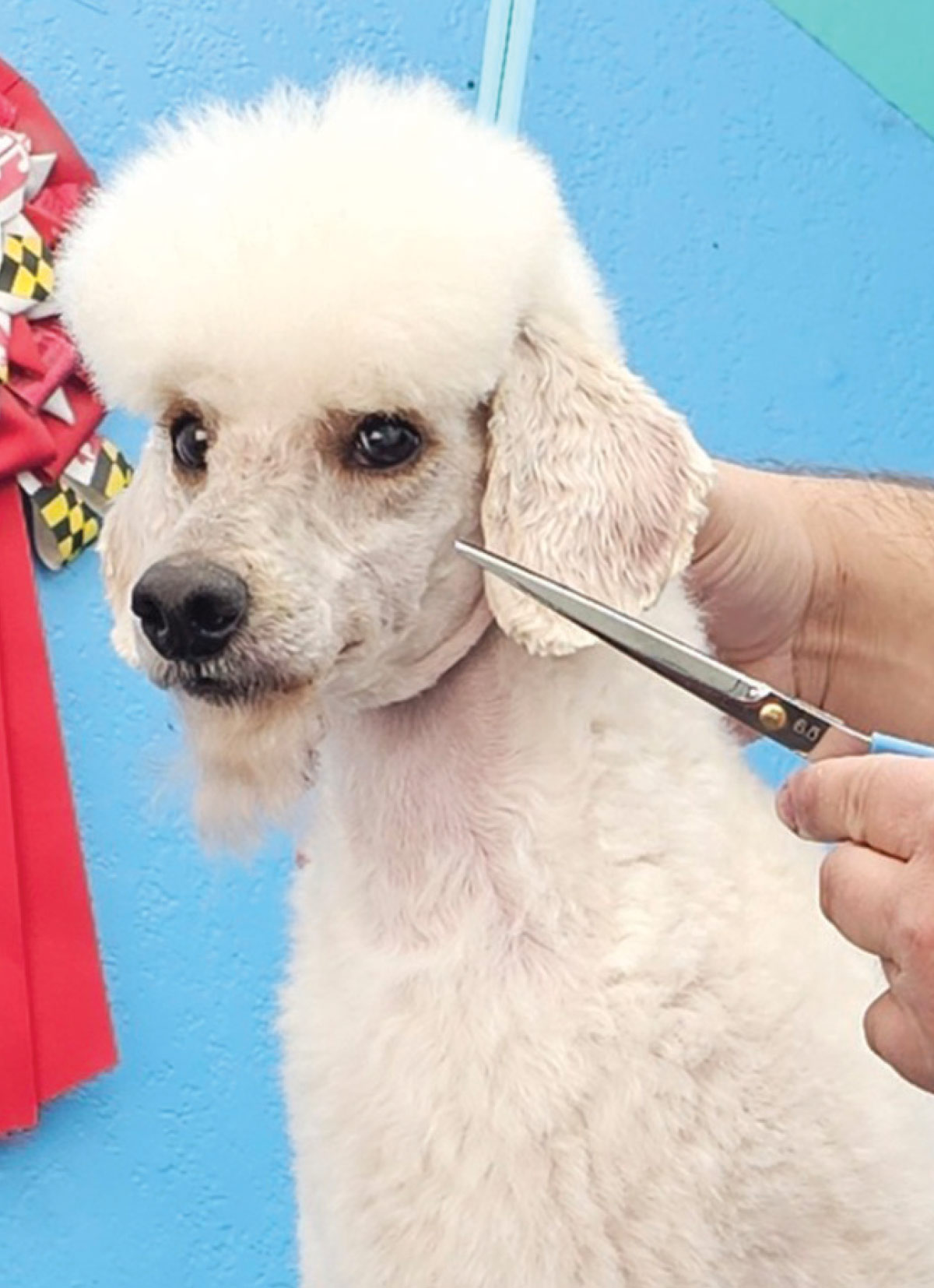
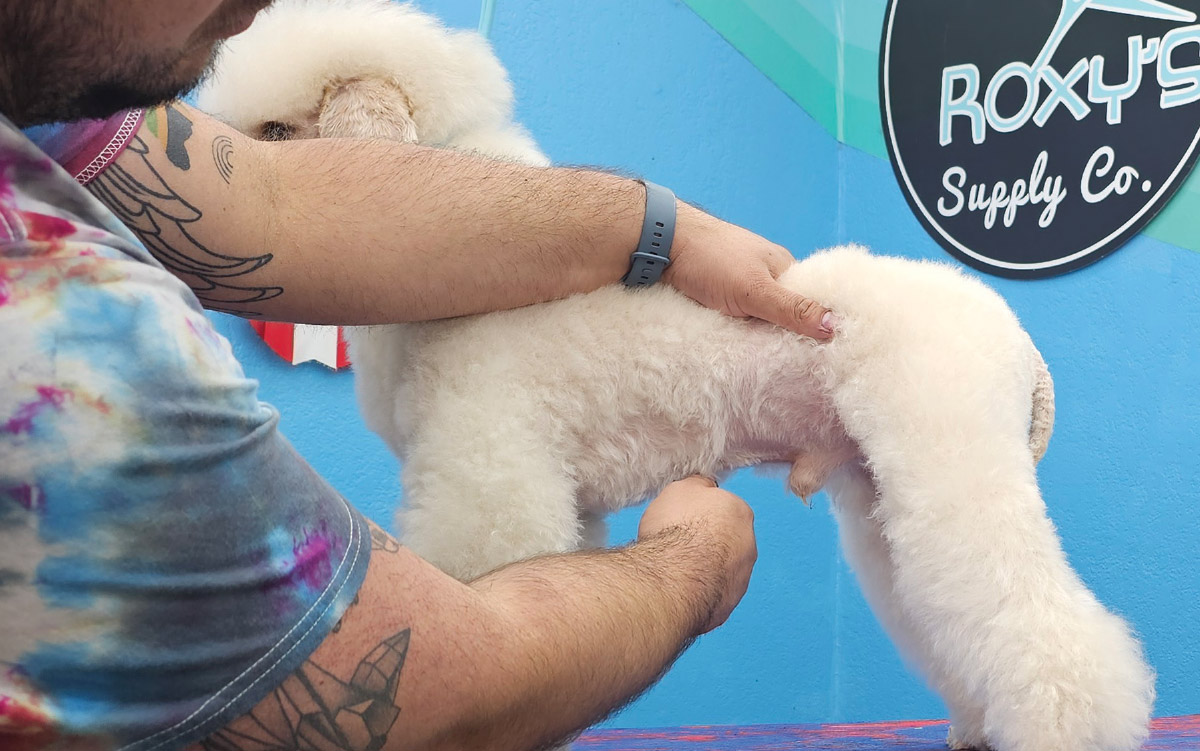


Fig. 10) There is nothing wrong with accessing the belly by standing certain dogs on their hind legs, but for others it is irresponsible or impossible. Next time you need to shave the belly on a large or athletically-challenged dog, try using your hand to rotate the belly skin upward on the side and access it that way.
Always remember—safety first, style second. You’ll keep yourself and the dogs you groom safer, and your clients will love you forever.



Call (717) 691-3388 ext 224 to place a Classified.
Rates: 25 words or less, $50.00.
Classified ads must be prepaid.
Call for issue deadlines.
Agency discounts do not apply.


Thanks for reading our April 2025 issue!





